Document Outline
- Specifications
- Pinout
- Package drawings
- Untitled
- Features
- Product Description
- Absolute Maximum Ratings
- Functional Block Diagram
- ARCHITECTURE OVERVIEW
- PIN DESCRIPTIONS
- LOW POWER OPERATION
- MEMORY ARCHITECTURE
- BIASED ROUNDING
- INSTRUCTION SET DESCRIPTION
- DESIGNING AN EZ-ICE-COMPATIBLE SYSTEM
- ESD SENSITIVITY
- GENERAL NOTES
- MEMORY TIMING SPECIFICATIONS
- TIMING NOTES
- FREQUENCY DEPENDENCY FOR TIMING SPECIFICATIONS
- POWER DISSIPATION
- CAPACITIVE LOADING
- TEST CONDITIONS
- ENVIRONMENTAL CONDITIONS
- Diagrams
- Block Diagram
- Basic System Configuration
- External Crystal Connections
- Program Memory (Mode B = 0)
- Program Memory (Mode B = 1)
- Data Memory
- System Control Register
- BDMA Control Register
- Boot Mode Circuit
- Target Board Connector for EZ-ICE
- Clock Signals
- Interrupts and Flags
- Bus RequestÖBus Grant
- Memory Read
- Memory Write
- Serial Ports
- IDMA Address Latch
- IDMA Write, Short Write Cycle
- IDMA Write, Long Write Cycle
- IDMA Read, Long Read Cycle
- IDMA Read, Short Read Cycle
- Voltage Reference Levels for AC Measurements (Except Output Enable/Disable)
- Output Enable/Disable
- Equivalent Device Loading for AC Measurements (Including All Fixtures)

REV. B
Information furnished by Analog Devices is believed to be accurate and
reliable. However, no responsibility is assumed by Analog Devices for its
use, nor for any infringements of patents or other rights of third parties
which may result from its use. No license is granted by implication or
otherwise under any patent or patent rights of Analog Devices.
a
ADSP-2186L
One Technology Way, P.O. Box 9106, Norwood, MA 02062-9106, U.S.A.
Tel: 781/329-4700
World Wide Web Site: http://www.analog.com
Fax: 781/326-8703
© Analog Devices, Inc., 2001
DSP Microcomputer
FUNCTIONAL BLOCK DIAGRAM
TIMER
DATA ADDRESS
GENERATORS
DAG 2
DAG 1
SERIAL PORTS
SPORT 1
SPORT 0
8K 16
DATA
MEMORY
8K 24
PROGRAM
MEMORY
DATA MEMORY DATA
DATA MEMORY ADDRESS
PROGRAMMABLE
I/O
AND
FLAGS
BYTE DMA
CONTROLLER
MEMORY
ADSP-2100 BASE
ARCHITECTURE
SHIFTER
MAC
ALU
ARITHMETIC UNITS
POWER-DOWN
CONTROL
PROGRAM
SEQUENCER
PROGRAM MEMORY ADDRESS
PROGRAM MEMORY DATA
EXTERNAL
DATA
BUS
EXTERNAL
ADDRESS
BUS
INTERNAL
DMA
PORT
EXTERNAL
DATA
BUS
OR
FULL MEMORY
MODE
HOST MODE
FEATURES
Performance
25 ns Instruction Cycle Time 40 MIPS Sustained
Performance
Single-Cycle Instruction Execution
Single-Cycle Context Switch
3-Bus Architecture Allows Dual Operand Fetches in
Every Instruction Cycle
Multifunction Instructions
Power-Down Mode Featuring Low CMOS Standby
Power Dissipation with 400 Cycle Recovery from
Power-Down Condition
Low Power Dissipation in Idle Mode
Integration
ADSP-2100 Family Code Compatible, with Instruction
Set Extensions
40K Bytes of On-Chip RAM, Configured as
8K Words On-Chip Program Memory RAM and
8K Words On-Chip Data Memory RAM
Dual Purpose Program Memory for Both Instruction
and Data Storage
Independent ALU, Multiplier/Accumulator and Barrel
Shifter Computational Units
Two Independent Data Address Generators
Powerful Program Sequencer Provides
Zero Overhead Looping Conditional Instruction
Execution
Programmable 16-Bit Interval Timer with Prescaler
100-Lead LQFP and 144-Ball Mini-BGA
System Interface
16-Bit Internal DMA Port for High Speed Access to
On-Chip Memory (Mode Selectable)
4 MByte Byte Memory Interface for Storage of Data
Tables and Program Overlays
8-Bit DMA to Byte Memory for Transparent Program
and Data Memory Transfers (Mode Selectable)
I/O Memory Interface with 2048 Locations Supports
Parallel Peripherals (Mode Selectable)
Programmable Memory Strobe and Separate I/O Memory
Space Permits "Glueless" System Design
(Mode Selectable)
Programmable Wait State Generation
Two Double-Buffered Serial Ports with Companding
Hardware and Automatic Data Buffering
Automatic Booting of On-Chip Program Memory from
Byte-Wide External Memory, e.g., EPROM, or
Through Internal DMA Port
Six External Interrupts
13 Programmable Flag Pins Provide Flexible System
Signaling
UART Emulation through Software SPORT Reconfiguration
ICE-PortTM Emulator Interface Supports Debugging
in Final Systems
GENERAL DESCRIPTION
The ADSP-2186L is a single-chip microcomputer optimized for
digital signal processing (DSP) and other high speed numeric
processing applications.
The ADSP-2186L combines the ADSP-2100 family base archi-
tecture (three computational units, data address generators
and a program sequencer) with two serial ports, a 16-bit inter-
nal DMA port, a byte DMA port, a programmable timer, Flag
I/O, extensive interrupt capabilities and on-chip program and
data memory.
The ADSP-2186L integrates 40K bytes of on-chip memory
configured as 8K words (24-bit) of program RAM and 8K
words (16-bit) of data RAM. Power-down circuitry is also pro-
vided to meet the low power needs of battery operated portable
equipment. The ADSP-2186L is available in a 100-lead LQFP
and 144-ball mini-BGA packages.
In addition, the ADSP-2186L supports new instructions, which
include bit manipulations--bit set, bit clear, bit toggle, bit test--
new ALU constants, new multiplication instruction (x squared),
biased rounding, result free ALU operations, I/O memory trans-
fers and global interrupt masking for increased flexibility.
Fabricated in a high speed, double metal, low power, CMOS
process, the ADSP-2186L operates with a 25 ns instruction cycle
time. Every instruction can execute in a single processor cycle.
The ADSP-21xx family DSPs contain a shadow bank register
that is useful for single cycle context switching of the processor.
ICE-Port is a trademark of Analog Devices, Inc.
All other trademarks are the property of their respective holders.
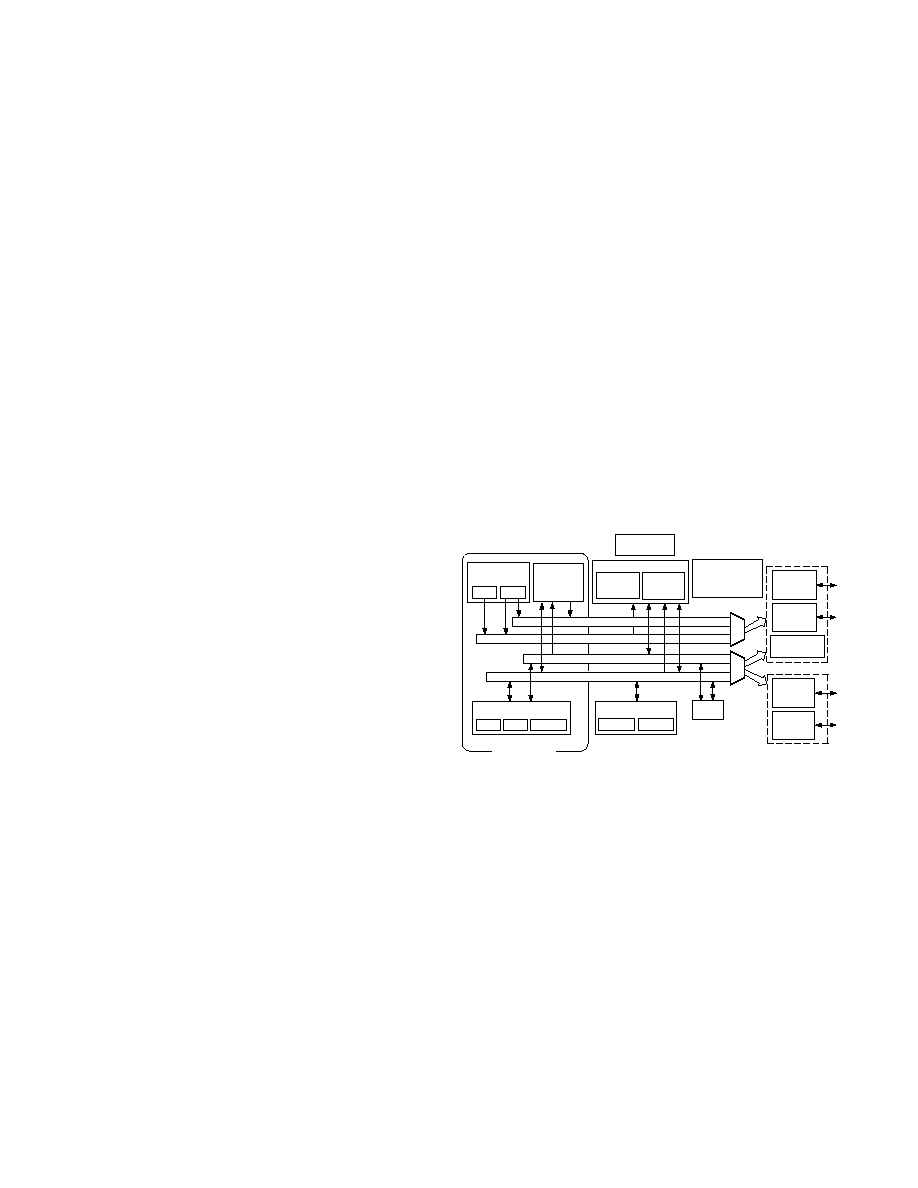
ADSP-2186L
≠2≠
REV. B
The ADSP-2186L's flexible architecture and comprehensive
instruction set allow the processor to perform multiple opera-
tions in parallel. In one processor cycle the ADSP-2186L can:
∑ Generate the next program address
∑ Fetch the next instruction
∑ Perform one or two data moves
∑ Update one or two data address pointers
∑ Perform a computational operation
This takes place while the processor continues to:
∑ Receive and transmit data through the two serial ports
∑ Receive and/or transmit data through the internal DMA port
∑ Receive and/or transmit data through the byte DMA port
∑ Decrement timer
Development System
The ADSP-2100 Family Development Software, a complete set
of tools for software and hardware system development, sup-
ports the ADSP-2186L. The Assembler has an algebraic syntax
that is easy to program and debug. The Linker combines object
files into an executable file. The Simulator provides an interactive
instruction- level simulation with a reconfigurable user interface
to display different portions of the hardware environment. A
PROM Splitter generates PROM programmer compatible
files. The C Compiler, based on the Free Software Foundation's
GNU C Compiler, generates ADSP-2186L assembly source
code. The source code debugger allows programs to be cor-
rected in the C environment. The Runtime Library includes over
100 ANSI-standard mathematical and DSP-specific functions.
The EZ-KIT Lite is a hardware/software kit offering a complete
development environment for the ADSP-218x family: an ADSP-
218x-based evaluation board with PC monitor software plus
Assembler, Linker, Simulator, and PROM Splitter software.
The ADSP-218x EZ-KIT Lite is a low-cost, easy-to-use hard-
ware platform on which you can quickly get started with your
DSP software design. The EZ-KIT Lite includes the following
features:
∑ 75 MHz ADSP-2189M
∑ Full 16-bit Stereo Audio I/O with AD73322 Codec
∑ RS-232 Interface
∑ EZ-ICE Connector for Emulator Control
∑ DSP Demo Programs
∑ Evaluation Suite of Visual DSP
The ADSP-218x EZ-ICE
Emulator aids in the hardware debug-
ging of an ADSP-2186L system. The emulator consists of hard-
ware, host computer resident software, and the target board
connector. The ADSP-2186L integrates on-chip emulation
support with a 14-pin ICE-Port interface. This interface provides a
simpler target board connection that requires fewer mechanical
clearance considerations than other ADSP-2100 Family EZ-ICEs.
The ADSP-2186L device need not be removed from the target
system when using the EZ-ICE, nor are any adapters needed. Due
to the small footprint of the EZ-ICE connector, emulation can
be supported in final board designs.
The EZ-ICE
performs a full range of functions, including:
∑ In-target operation
∑ Up to 20 breakpoints
∑ Single-step or full-speed operation
∑ Registers and memory values can be examined and altered
∑ PC upload and download functions
∑ Instruction-level emulation of program booting and execution
∑ Complete assembly and disassembly of instructions
∑ C source-level debugging
See Designing An EZ-ICE-Compatible Target System in the
ADSP-2100 Family EZ-Tools Manual (ADSP-2181 sections), as
well as the Target Board Connector for EZ-ICE
Probe section
of this data sheet, for the exact specifications of the EZ-ICE
target board connector.
Additional Information
This data sheet provides a general overview of ADSP-2186L
functionality. For additional information on the architecture and
instruction set of the processor, refer to the ADSP-218x DSP
Hardware Reference. For more information about the develop-
ment tools, refer to the ADSP-2100 Family Development Tools
Data Sheet.
ARCHITECTURE OVERVIEW
The ADSP-2186L instruction set provides flexible data moves
and multifunction (one or two data moves with a computation)
instructions. Every instruction can be executed in a single pro-
cessor cycle. The ADSP-2186L assembly language uses an alge-
braic syntax for ease of coding and readability. A comprehensive
set of development tools supports program development.
TIMER
DATA ADDRESS
GENERATORS
DAG 2
DAG 1
SERIAL PORTS
SPORT 1
SPORT 0
8K 16
DATA
MEMORY
8K 24
PROGRAM
MEMORY
DATA MEMORY DATA
DATA MEMORY ADDRESS
PROGRAMMABLE
I/O
AND
FLAGS
BYTE DMA
CONTROLLER
MEMORY
ADSP-2100 BASE
ARCHITECTURE
SHIFTER
MAC
ALU
ARITHMETIC UNITS
POWER-DOWN
CONTROL
PROGRAM
SEQUENCER
PROGRAM MEMORY ADDRESS
PROGRAM MEMORY DATA
EXTERNAL
DATA
BUS
EXTERNAL
ADDRESS
BUS
INTERNAL
DMA
PORT
EXTERNAL
DATA
BUS
OR
FULL MEMORY
MODE
HOST MODE
Figure 1. Block Diagram
Figure 1 is an overall block diagram of the ADSP-2186L. The
processor contains three independent computational units: the
ALU, the multiplier/accumulator (MAC) and the shifter. The
computational units process 16-bit data directly and have provi-
sions to support multiprecision computations. The ALU per-
forms a standard set of arithmetic and logic operations; division
primitives are also supported. The MAC performs single-cycle
multiply, multiply/add and multiply/subtract operations with
40 bits of accumulation. The shifter performs logical and arith-
metic shifts, normalization, denormalization and derive expo-
nent operations.
The shifter can be used to efficiently implement numeric
format control including multiword and block floating-point
representations.
The internal result (R) bus connects the computational units so
the output of any unit may be the input of any unit on the
next cycle.
SoundPort and EZ-ICE are registered trademarks of Analog Devices, Inc.

ADSP-2186L
≠3≠
REV. B
A powerful program sequencer and two dedicated data address
generators ensure efficient delivery of operands to these compu-
tational units. The sequencer supports conditional jumps, sub-
routine calls and returns in a single cycle. With internal loop
counters and loop stacks, the ADSP-2186L executes looped code
with zero overhead; no explicit jump instructions are required to
maintain loops.
Two data address generators (DAGs) provide addresses for
simultaneous dual operand fetches from data memory and pro-
gram memory. Each DAG maintains and updates four address
pointers. Whenever the pointer is used to access data (indirect
addressing), it is post-modified by the value of one of four pos-
sible modify registers. A length value may be associated with
each pointer to implement automatic modulo addressing for
circular buffers.
Efficient data transfer is achieved with the use of five internal
buses:
∑ Program Memory Address (PMA) Bus
∑ Program Memory Data (PMD) Bus
∑ Data Memory Address (DMA) Bus
∑ Data Memory Data (DMD) Bus
∑ Result (R) Bus
The two address buses (PMA and DMA) share a single external
address bus, allowing memory to be expanded off-chip, and the
two data buses (PMD and DMD) share a single external data
bus. Byte memory space and I/O memory space also share the
external buses.
Program memory can store both instructions and data, permit-
ting the ADSP-2186L to fetch two operands in a single cycle,
one from program memory and one from data memory. The
ADSP-2186L can fetch an operand from program memory and
the next instruction in the same cycle.
When configured in host mode, the ADSP-2186L has a 16-bit
Internal DMA port (IDMA port) for connection to external
systems. The IDMA port is made up of 16 data/address pins
and five control pins. The IDMA port provides transparent,
direct access to the DSPs on-chip program and data RAM.
An interface to low cost byte-wide memory is provided by the
Byte DMA port (BDMA port). The BDMA port is bidirectional
and can directly address up to four megabytes of external RAM
or ROM for off-chip storage of program overlays or data tables.
The byte memory and I/O memory space interface supports
slow memories and I/O memory-mapped peripherals with
programmable wait state generation. External devices can
gain control of external buses with bus request/grant signals
(
BR, BGH and BG). One execution mode (Go Mode) allows
the ADSP-2186L to continue running from on-chip memory.
Normal execution mode requires the processor to halt while
buses are granted.
The ADSP-2186L can respond to 11 interrupts. There are up to
six external interrupts (one edge-sensitive, two level-sensitive and
three configurable) and seven internal interrupts generated by
the timer, the serial ports (SPORTs), the Byte DMA port and
the power-down circuitry. There is also a master
RESET inter-
rupt. The two serial ports provide a complete synchronous serial
interface with optional companding in hardware and a wide
variety of framed or frameless data transmit and receive modes
of operation.
Each port can generate an internal programmable serial clock or
accept an external serial clock.
The ADSP-2186L provides up to 13 general-purpose flag pins.
The data input and output pins on SPORT1 can be alternatively
configured as an input flag and an output flag. In addition, eight
flags are programmable as inputs or outputs, and three flags are
always outputs.
A programmable interval timer generates periodic interrupts. A
16-bit count register (TCOUNT) decrements every n processor
cycles, where n is a scaling value stored in an 8-bit register
(TSCALE). When the value of the count register reaches zero,
an interrupt is generated and the count register is reloaded from
a 16-bit period register (TPERIOD).
Serial Ports
The ADSP-2186L incorporates two complete synchronous
serial ports (SPORT0 and SPORT1) for serial communications
and multiprocessor communication.
Here is a brief list of the capabilities of the ADSP-2186L SPORTs.
For additional information on Serial Ports, refer to the ADSP-218x
DSP Hardware Reference.
∑ SPORTs are bidirectional and have a separate, double-
buffered transmit and receive section.
∑ SPORTs can use an external serial clock or generate their own
serial clock internally.
∑ SPORTs have independent framing for the receive and trans-
mit sections. Sections run in a frameless mode or with frame
synchronization signals internally or externally generated.
Frame sync signals are active high or inverted, with either of
two pulsewidths and timings.
∑ SPORTs support serial data word lengths from 3 to 16 bits
and provide optional A-law and
µ-law companding according
to CCITT recommendation G.711.
∑ SPORT receive and transmit sections can generate unique
interrupts on completing a data word transfer.
∑ SPORTs can receive and transmit an entire circular buffer of
data with only one overhead cycle per data word. An interrupt
is generated after a data buffer transfer.
∑ SPORT0 has a multichannel interface to selectively receive
and transmit a 24- or 32-word, time-division multiplexed,
serial bitstream.
∑ SPORT1 can be configured to have two external interrupts
(
IRQ0 and IRQ1) and the Flag In and Flag Out signals. The
internally generated serial clock may still be used in this
configuration.
PIN DESCRIPTIONS
The ADSP-2186L is available in a 100-lead LQFP and a 144-ball
Mini-BGA package. In order to maintain maximum functionality
and reduce package size and pin count, some serial port, pro-
grammable flag, interrupt and external bus pins have dual,
multiplexed functionality. The external bus pins are config-
ured during
RESET only, while serial port pins are software
configurable during program execution. Flag and interrupt
functionality is retained concurrently on multiplexed pins. In
cases where pin functionality is reconfigurable, the default state is
shown in plain text; alternate functionality is shown in italics.

ADSP-2186L
≠4≠
REV. B
Common-Mode Pins
#
Input/
Pin
of
Out-
Name(s)
Pins put
Function
RESET
1
I
Processor Reset Input
BR
1
I
Bus Request Input
BG
1
O
Bus Grant Output
BGH
1
O
Bus Grant Hung Output
DMS
1
O
Data Memory Select Output
PMS
1
O
Program Memory Select Output
IOMS
1
O
Memory Select Output
BMS
1
O
Byte Memory Select Output
CMS
1
O
Combined Memory Select Output
RD
1
O
Memory Read Enable Output
WR
1
O
Memory Write Enable Output
IRQ2/
1
I
Edge- or Level-Sensitive
Interrupt Request
1
PF7
I/O
Programmable I/O Pin
IRQL0/
1
I
Level-Sensitive Interrupt Requests
1
PF5
I/O
Programmable I/O Pin
IRQL1/
1
I
Level-Sensitive Interrupt Requests
1
PF6
I/O
Programmable I/O Pin
IRQE/
1
I
Edge-Sensitive Interrupt Requests
1
PF4
I/O
Programmable I/O Pin
PF3
1
I/O
Programmable I/O Pin
Mode C/
1
I
Mode Select Input--Checked
only During
RESET
PF2
I/O
Programmable I/O Pin During
Normal Operation
Mode B/
1
I
Mode Select Input--Checked
only During
RESET
PF1
I/O
Programmable I/O Pin During
Normal Operation
Mode A/
1
I
Mode Select Input--Checked
only During
RESET
PF0
I/O
Programmable I/O Pin During
Normal Operation
CLKIN, XTAL
2
I
Clock or Quartz Crystal Input
CLKOUT
1
O
Processor Clock Output
SPORT0
5
I/O
Serial Port I/O Pins
SPORT1
5
I/O
Serial Port I/O Pins
IRQ1:0
Edge- or Level-Sensitive Interrupts,
FI, FO
Flag In, Flag Out
2
PWD
1
I
Power-Down Control Input
PWDACK
1
O
Power-Down Control Output
FL0, FL1, FL2
3
O
Output Flags
V
DD
6
I
Power (LQFP)
GND
10
I
Ground (LQFP)
V
DD
11
I
Power (Mini-BGA)
GND
20
I
Ground (Mini-BGA)
EZ-Port
9
I/O
For Emulation Use
3
NOTES
1
Interrupt/Flag pins retain both functions concurrently. If IMASK is set to
enable the corresponding interrupts, the DSP will vector to the appropriate
interrupt vector address when the pin is asserted, either by external devices or
set as a programmable flag.
2
SPORT configuration determined by the DSP System Control Register. Soft-
ware configurable.
3
See Designing an EZ-ICE-Compatible System in this data sheet for complete
information.
Memory Interface Pins
The ADSP-2186L processor can be used in one of two modes:
Full Memory Mode, which allows BDMA operation with full
external overlay memory and I/O capability, or Host Mode, which
allows IDMA operation with limited external addressing capabili-
ties. The operating mode is determined by the state of the Mode C
pin during
RESET and cannot be changed while the processor is
running. (See Table VI for complete mode operation descriptions.)
Full Memory Mode Pins (Mode C = 0)
#
of
Input/
Pin Name
Pins
Output
Function
A13:0
14
O
Address Output Pins for Pro-
gram, Data, Byte and I/O Spaces
D23:0
24
I/O
Data I/O Pins for Program,
Data, Byte and I/O Spaces
(8 MSBs Are Also Used as
Byte Memory Addresses)
Host Mode Pins (Mode C = 1)
#
of
Input/
Pin Name
Pins
Output
Function
IAD15:0
16
I/O
IDMA Port Address/Data Bus
A0
1
O
Address Pin for External I/O,
Program, Data or Byte Access
D23:8
16
I/O
Data I/O Pins for Program,
Data Byte and I/O Spaces
IWR
1
I
IDMA Write Enable
IRD
1
I
IDMA Read Enable
IAL
1
I
IDMA Address Latch Pin
IS
1
I
IDMA Select
IACK
1
O
IDMA Port Acknowledge
In Host Mode, external peripheral addresses can be decoded using the A0,
CMS, PMS, DMS and IOMS signals.
Terminating Unused Pin
The following table shows the recommendations for terminating
unused pins.
Pin Terminations
I/O
Hi-Z
*
Pin
3-State
Reset
Caused
Unused
Name
(Z)
State
By
Configuration
XTAL
I
I
Float
CLKOUT
O
O
Float
A13:1 or
O (Z)
Hi-Z
BR, EBR
Float
IAD12:0
I/O (Z)
Hi-Z
IS
Float
A0
O (Z)
Hi-Z
BR, EBR
Float
D23:8
I/O (Z)
Hi-Z
BR, EBR
Float
D7 or
I/O (Z)
Hi-Z
BR, EBR
Float
IWR
I
I
High (Inactive)
D6 or
I/O (Z)
Hi-Z
BR, EBR
Float
IRD
I
I
BR, EBR
High (Inactive)
D5 or
I/O (Z)
Hi-Z
Float
IAL
I
I
Low (Inactive)

ADSP-2186L
≠5≠
REV. B
Pin Terminations (Continued)
I/O
Hi-Z
*
Pin
3-State
Reset
Caused
Unused
Name
(Z)
State
By
Configuration
D4 or
I/O (Z)
Hi-Z
BR, EBR
Float
IS
I
I
High (Inactive)
D3 or
I/O (Z)
Hi-Z
BR, EBR
Float
IACK
Float
D2:0 or
I/O (Z)
Hi-Z
BR, EBR
Float
IAD15:13
I/O (Z)
Hi-Z
IS
Float
PMS
O (Z)
O
BR, EBR
Float
DMS
O (Z)
O
BR, EBR
Float
BMS
O (Z)
O
BR, EBR
Float
IOMS
O (Z)
O
BR, EBR
Float
CMS
O (Z)
O
BR, EBR
Float
RD
O (Z)
O
BR, EBR
Float
WR
O (Z)
O
BR, EBR
Float
BR
I
I
High (Inactive)
BG
O (Z)
O
EE
Float
BGH
O
O
Float
IRQ2/PF7
I/O (Z)
I
Input = High (Inactive)
or Program as Output,
Set to 1, Let Float
IRQL1/PF6
I/O (Z)
I
Input = High (Inactive)
or Program as Output,
Set to 1, Let Float
IRQL0/PF5
I/O (Z)
I
Input = High (Inactive)
or Program as Output,
Set to 1, Let Float
IRQE/PF4
I/O (Z)
I
Input = High (Inactive)
or Program as Output,
Set to 1, Let Float
SCLK0
I/O
I
Input = High or Low,
Output = Float
RFS0
I/O
I
High or Low
DR0
I
I
High or Low
TFS0
I/O
O
High or Low
DT0
O
O
Float
SCLK1
I/O
I
Input = High or Low,
Output = Float
RFS1/
IRQ0
I/O
I
High or Low
DR1/FI
I
I
High or Low
TFS1/
IRQ1
I/O
O
High or Low
DT1/FO
O
O
Float
EE
I
I
EBR
I
I
EBG
O
O
ERESET
I
I
EMS
O
O
EINT
I
I
ECLK
I
I
ELIN
I
I
ELOUT
O
O
NOTES
*Hi-Z = High Impedance.
1. If the CLKOUT pin is not used, turn it OFF, using CLKODIS in Sport0
autobuffer control register.
2. If the Interrupt/Programmable Flag pins are not used, there are two options:
Option 1: When these pins are configured as INPUTS at reset and function as
interrupts and input flag pins, pull the pins High (inactive).
Option 2: Program the unused pins as OUTPUTS, set them to 1, and let
them float.
3. All bidirectional pins have three-stated outputs. When the pin is configured as
an output, the output is Hi-Z (high impedance) when inactive.
4. CLKIN,
RESET, and PF3:0 are not included in the table because these pins
must be used.
Setting Memory Mode
Memory Mode selection for the ADSP-2186L is made during
chip reset through the use of the Mode C pin. This pin is multi-
plexed with the DSP's PF2 pin, so care must be taken in how
the mode selection is made. The two methods for selecting the
value of Mode C are passive and active.
Passive configuration involves the use of a pull-up or pull-down
resistor connected to the Mode C pin. To minimize power
consumption, or if the PF2 pin is to be used as an output in the
DSP application, a weak pull-up or pull-down, on the order of
100 k
, can be used. This value should be sufficient to pull the
pin to the desired level and still allow the pin to operate as a
programmable flag output without undue strain on the processor's
output driver. For minimum power consumption during
power-down, reconfigure PF2 to be an input, as the pull-up or
pull-down will hold the pin in a known state, and will not switch.
Active configuration involves the use of a three-stateable external
driver connected to the Mode C pin. A driver's output enable
should be connected to the DSP's
RESET signal such that it
only drives the PF2 pin when
RESET is active (low). After
RESET is deasserted, the driver should three-state, thus allow-
ing full use of the PF2 pin as either an input or output.
To minimize power consumption during power-down, configure
the programmable flag as an output when connected to a three-
stated buffer. This ensures that the pin will be held at a constant
level and not oscillate should the three-state driver's level hover
around the logic switching point.
Interrupts
The interrupt controller allows the processor to respond to the
thirteen possible interrupts (eleven of which can be enabled
at any one time), and
RESET with minimum overhead. The
ADSP-2186L provides four dedicated external interrupt input
pins,
IRQ2, IRQL0, IRQL1 and IRQE (shared with the PF7:4
pins). In addition, SPORT1 may be reconfigured for
IRQ0,
IRQ1, FI and FO, for a total of six external interrupts. The
ADSP-2186L also supports internal interrupts from the timer,
the byte DMA port, the two serial ports, software and the
power-down control circuit. The interrupt levels are internally
prioritized and individually maskable (except power-down and
RESET). The IRQ2, IRQ0 and IRQ1 input pins can be pro-
grammed to be either level- or edge-sensitive.
IRQL0 and
IRQL1 are level-sensitive and IRQE is edge-sensitive. The priori-
ties and vector addresses of all interrupts are shown in Table I.
Table I. Interrupt Priority and Interrupt Vector Addresses
Source Of Interrupt
Interrupt Vector Address (Hex)
RESET (or Power-Up with
PUCR = 1)
0000 (Highest Priority)
Power-Down (Nonmaskable)
002C
IRQ2
0004
IRQL1
0008
IRQL0
000C
SPORT0 Transmit
0010
SPORT0 Receive
0014
IRQE
0018
BDMA Interrupt
001C
SPORT1 Transmit or
IRQ1 0020
SPORT1 Receive or
IRQ0
0024
Timer
0028 (Lowest Priority)

ADSP-2186L
≠6≠
REV. B
Interrupt routines can either be nested, with higher priority
interrupts taking precedence, or processed sequentially. Inter-
rupts can be masked or unmasked with the IMASK register.
Individual interrupt requests are logically ANDed with the bits
in IMASK; the highest priority unmasked interrupt is then
selected. The power-down interrupt is nonmaskable.
The ADSP-2186L masks all interrupts for one instruction cycle
following the execution of an instruction that modifies the
IMASK register. This does not affect serial port autobuffering
or DMA transfers.
The interrupt control register, ICNTL, controls interrupt nest-
ing and defines the
IRQ0, IRQ1 and IRQ2 external interrupts to
be either edge- or level-sensitive. The
IRQE pin is an external
edge-sensitive interrupt and can be forced and cleared. The
IRQL0 and IRQL1 pins are external level-sensitive interrupts.
The IFC register is a write-only register used to force and clear
interrupts.
On-chip stacks preserve the processor status and are automati-
cally maintained during interrupt handling. The stacks are twelve
levels deep to allow interrupt, loop and subroutine nesting.
The following instructions allow global enable or disable servic-
ing of the interrupts (including power-down), regardless of the
state of IMASK. Disabling the interrupts does not affect serial
port autobuffering or DMA.
ENA INTS;
DIS INTS;
When the processor is reset, interrupt servicing is enabled.
LOW POWER OPERATION
The ADSP-2186L has three low power modes that significantly
reduce the power dissipation when the device operates under
standby conditions. These modes are:
∑ Power-Down
∑ Idle
∑ Slow Idle
The CLKOUT pin may also be disabled to reduce external
power dissipation.
Power-Down
The ADSP-2186L processor has a low power feature that lets
the processor enter a very low power dormant state through
hardware or software control. Following is a brief list of power-
down features. Refer to the ADSP-218x DSP Hardware Reference,
"System Interface" chapter, for detailed information about the
power-down feature.
∑
Quick recovery from power-down. The processor begins
executing instructions in as few as 400 CLKIN cycles.
∑
Support for an externally generated TTL or CMOS proces-
sor clock. The external clock can continue running during
power-down without affecting the lowest power rating and
400 CLKIN cycle recovery.
∑
Support for crystal operation includes disabling the oscillator
to save power (the processor automatically waits approxi-
mately 4096 CLKIN cycles for the crystal oscillator to start
or stabilize), and letting the oscillator run to allow 400 CLKIN
cycle start-up.
∑
Power-down is initiated by either the power-down pin (
PWD)
or the software power-down force bit.
∑
Interrupt support allows an unlimited number of instructions
to be executed before optionally powering down. The power-
down interrupt also can be used as a nonmaskable, edge-
sensitive interrupt.
∑
Context clear/save control allows the processor to continue
where it left off or start with a clean context when leaving the
power-down state.
∑
The
RESET pin also can be used to terminate power-down.
∑
Power-down acknowledge (PWDACK) pin indicates when
the processor has entered power-down.
Idle
When the ADSP-2186L is in the Idle Mode, the processor waits
indefinitely in a low power state until an interrupt occurs. When
an unmasked interrupt occurs, it is serviced; execution then con-
tinues with the instruction following the IDLE instruction. In Idle
mode IDMA, BDMA and autobuffer cycle steals still occur.
Slow Idle
The IDLE instruction is enhanced on the ADSP-2186L to let
the processor's internal clock signal be slowed, further reducing
power consumption. The reduced clock frequency, a program-
mable fraction of the normal clock rate, is specified by a select-
able divisor given in the IDLE instruction. The format of the
instruction is:
IDLE (n)
where n = 16, 32, 64 or 128. This instruction keeps the proces-
sor fully functional, but operating at the slower clock rate. While
it is in this state, the processor's other internal clock signals such
as SCLK, CLKOUT and timer clock, are reduced by the same
ratio. The default form of the instruction, when no clock divisor
is given, is the standard IDLE instruction.
When the IDLE (n) instruction is used, it effectively slows down
the processor's internal clock and thus its response time to incom-
ing interrupts. The one-cycle response time of the standard idle
state is increased by n, the clock divisor. When an enabled inter-
rupt is received, the ADSP-2186L will remain in the idle state
for up to a maximum of n processor cycles (n = 16, 32, 64 or
128) before resuming normal operation.
When the IDLE (n) instruction is used in systems that have an
externally generated serial clock (SCLK), the serial clock rate
may be faster than the processor's reduced internal clock rate.
Under these conditions, interrupts must not be generated at a
faster rate than can be serviced due to the additional time the
processor takes to come out of the idle state (a maximum of n
processor cycles).
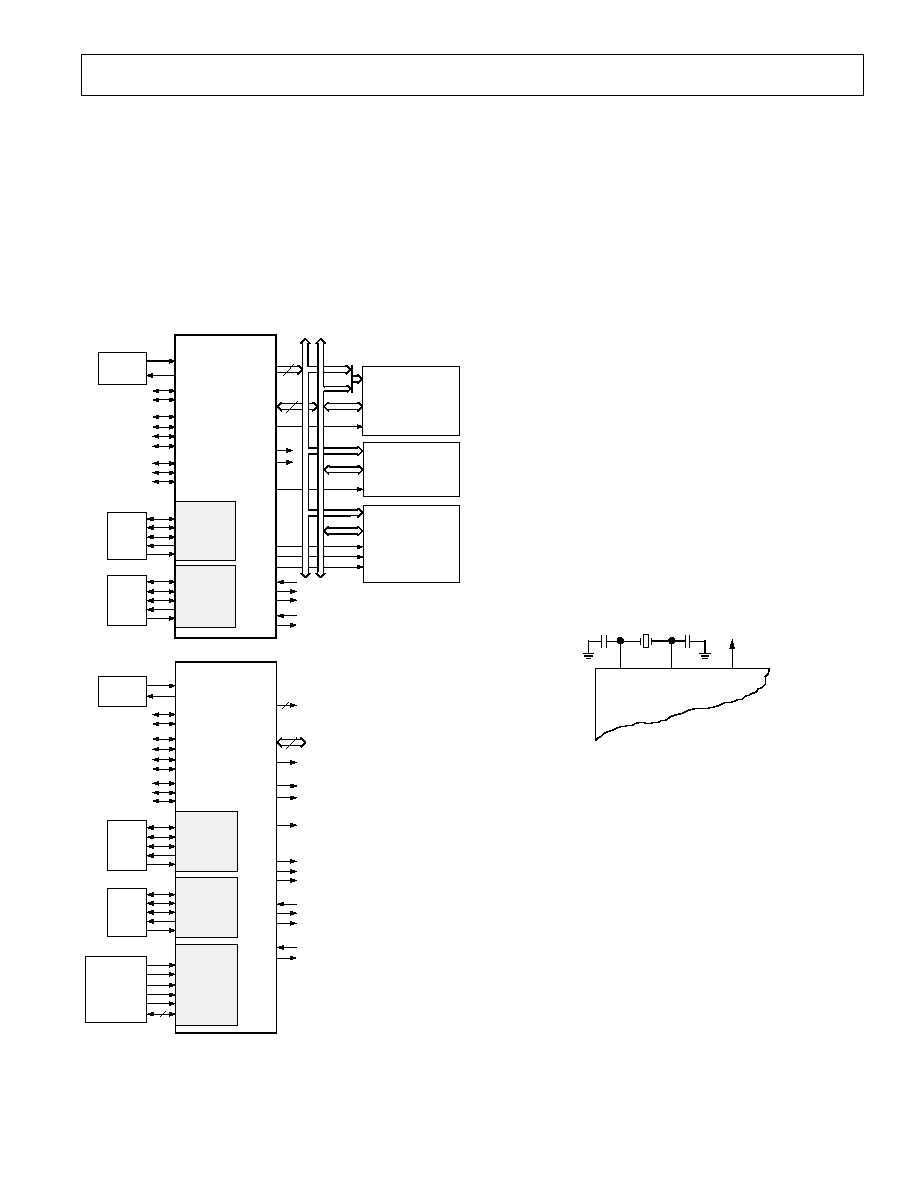
ADSP-2186L
≠7≠
REV. B
SYSTEM INTERFACE
Figure 2 shows typical basic system configurations with the
ADSP-2186L, two serial devices, a byte-wide EPROM and
optional external program and data overlay memories (mode
selectable). Programmable wait state generation allows the pro-
cessor to connect easily to slow peripheral devices. The ADSP-
2186L also provides four external interrupts and two serial ports
or six external interrupts and one serial port. Host Memory
Mode allows access to the full external data bus, but limits
addressing to a single address bit (A0). Additional system
peripherals can be added in this mode through the use of exter-
nal hardware to generate and latch address signals.
1/2x CLOCK
OR
CRYSTAL
SERIAL
DEVICE
SERIAL
DEVICE
SCLK1
RFS1 OR
IRQ0
TFS1 OR
IRQ1
DT1 OR FO
DR1 OR FI
SPORT1
SCLK0
RFS0
TFS0
DT0
DR0
SPORT0
A0≠A21
DATA
CS
CS
DATA
ADDR
DATA
ADDR
BYTE
MEMORY
I/O SPACE
(PERIPHERALS)
2048 LOCATIONS
OVERLAY
MEMORY
TWO 8K
PM SEGMENTS
TWO 8K
DM SEGMENTS
D
23≠0
A
13≠0
D
23≠8
A
10≠0
D
15≠8
D
23≠16
A
13≠0
14
24
FL0≠2
PF 3
CLKIN
XTAL
ADDR13≠0
DATA23≠0
BMS
IOMS
PMS
DMS
CMS
BR
BG
BGH
PWD
PWDACK
ADSP-2186L
1/2x CLOCK
OR
CRYSTAL
SERIAL
DEVICE
SERIAL
DEVICE
SYSTEM
INTERFACE
OR
CONTROLLER
16
1
16
SPORT1
SCLK0
RFS0
TFS0
DT0
DR0
SPORT0
IRD/D6
IWR/D7
IS/D4
IAL/D5
IACK/D3
IAD15≠0
IDMA PORT
FL0≠2
PF 3
CLKIN
XTAL
A0
DATA23≠8
BMS
IOMS
PMS
DMS
CMS
BR
BG
BGH
PWD
PWDACK
ADSP-2186L
IRQ2/PF 7
IRQE/PF 4
IRQL0/PF 5
IRQL1/PF 6
MODE C/PF 2
MODE B/PF 1
MODE A/PF 0
HOST MEMORY MODE
IRQ2/PF 7
IRQE/PF 4
IRQL0/PF 5
IRQL1/PF 6
MODE C/PF 2
MODE B/PF 1
MODE A/PF 0
FULL MEMORY MODE
WR
RD
WR
RD
TFS1 OR
IRQ1
DT1 OR FO
DR1 OR FI
SCLK1
RFS1 OR
IRQ0
Figure 2. Basic System Configuration
Clock Signals
The ADSP-2186L can be clocked by either a crystal or a
TTL-compatible clock signal.
The CLKIN input cannot be halted, changed during operation
or operated below the specified frequency during normal operation.
The only exception is while the processor is in the power-down
state. For additional information on the power-down feature,
refer to the ADSP-218x DSP Hardware Reference.
If an external clock is used, it should be a TTL-compatible
signal running at half the instruction rate. The signal is con-
nected to the processor's CLKIN input. When an external clock
is used, the XTAL input must be left unconnected.
The ADSP-2186L uses an input clock with a frequency equal to
half the instruction rate; a 0.20 MHz input clock yields a 25 ns
processor cycle (which is equivalent to 40 MHz). Normally,
instructions are executed in a single processor cycle. All device
timing is relative to the internal instruction clock rate, which is
indicated by the CLKOUT signal when enabled.
Because the ADSP-2186L includes an on-chip oscillator circuit,
an external crystal may be used. The crystal should be connected
across the CLKIN and XTAL pins, with two capacitors con-
nected as shown in Figure 3. Capacitor values are dependent on
crystal type and should be specified by the crystal manufacturer.
A parallel-resonant, fundamental frequency, microprocessor-
grade crystal should be used.
A clock output (CLKOUT) signal is generated by the proces-
sor at the processor's cycle rate. This can be enabled and
disabled by the CLKODIS bit in the SPORT0 Autobuffer
Control Register.
CLKIN
CLKOUT
XTAL
DSP
Figure 3. External Crystal Connections
Reset
The
RESET signal initiates a master reset of the ADSP-2186L.
The
RESET signal must be asserted during the power-up
sequence to assure proper initialization.
RESET during initial
power-up must be held long enough to allow the internal clock
to stabilize. If
RESET is activated any time after power-up, the
clock continues to run and does not require stabilization time.
The power-up sequence is defined as the total time required for
the crystal oscillator circuit to stabilize after a valid V
DD
is
applied to the processor, and for the internal phase-locked loop
(PLL) to lock onto the specific crystal frequency. A minimum of
2000 CLKIN cycles ensures that the PLL has locked, but does
not include the crystal oscillator start-up time. During this
power-up sequence the
RESET signal should be held low. On
any subsequent resets, the
RESET signal must meet the mini-
mum pulsewidth specification, t
RSP
.
The
RESET input contains some hysteresis; however, if an RC
circuit is used to generate the
RESET signal, an external Schmidt
trigger is recommended.

ADSP-2186L
≠8≠
REV. B
The master
RESET sets all internal stack pointers to the empty
stack condition, masks all interrupts and clears the MSTAT
register. When
RESET is released, if there is no pending bus
request and the chip is configured for booting, the boot-loading
sequence is performed. The first instruction is fetched from
on-chip program memory location 0x0000 once boot loading
completes. In an EZ-ICE-compatible system
RESET and
ERESET have the same functionality. For complete information,
see Designing an EZ-ICE-Compatible System section.
MEMORY ARCHITECTURE
The ADSP-2186L provides a variety of memory and peripheral
interface options. The key functional groups are Program Memory,
Data Memory, Byte Memory and I/O.
Program Memory (Full Memory Mode) is a 24-bit-wide space
for storing both instruction opcodes and data. The ADSP-2186L
has 8K words of Program Memory RAM on chip, and the capabil-
ity of accessing up to two 8K external memory overlay spaces using
the external data bus. Both an instruction opcode and a data value
can be read from on-chip program memory in a single cycle.
Data Memory (Full Memory Mode) is a 16-bit-wide space
used for the storage of data variables and for memory-mapped
control registers. The ADSP-2186L has 8K words on Data
Memory RAM on chip, consisting of 8160 user-accessible
locations and 32 memory-mapped registers. Support also exists
for up to two 8K external memory overlay spaces through the
external data bus.
Byte Memory (Full Memory Mode) provides access to an
8-bit wide memory space through the Byte DMA (BDMA) port.
The Byte Memory interface provides access to 4 MBytes of
memory by utilizing eight data lines as additional address lines.
This gives the BDMA Port an effective 22-bit address range. On
power-up, the DSP can automatically load bootstrap code from
byte memory.
I/O Space (Full Memory Mode) allows access to 2048 loca-
tions of 16-bit-wide data. It is intended to be used to communi-
cate with parallel peripheral devices such as data converters and
external registers or latches.
Program Memory
The ADSP-2186L contains an 8K
◊ 24 on-chip program RAM.
The on-chip program memory is designed to allow up to two
accesses each cycle so that all operations can complete in a
single cycle. In addition, the ADSP-2186L allows the use of 8K
external memory overlays.
The program memory space organization is controlled by the
Mode B pin and the PMOVLAY register. Normally, the ADSP-
2186L is configured with Mode B = 0 and program memory
organized as shown in Figure 4.
EXTERNAL 8K
(PMOVLAY = 1 or 2,
MODE B = 0)
0x3FFF
0x2000
0x1FFF
8K INTERNAL
0x0000
PROGRAM MEMORY
ADDRESS
Figure 4. Program Memory (Mode B = 0)
There are 8K words of memory accessible internally when the
PMOVLAY register is set to 0. When PMOVLAY is set to some-
thing other than 0, external accesses occur at addresses 0x2000
through 0x3FFF. The external address is generated as shown
in Table II.
Table II. PMOVLAY Addressing
PMOVLAY
Memory
A13
A12:0
0
Reserved
Not Applicable Not Applicable
1
External
13 LSBs of Address
Overlay 1
0
Between 0x2000
and 0x3FFF
2
External
13 LSBs of Address
Overlay 2
1
Between 0x2000
and 0x3FFF
NOTE: Addresses 0x2000 through 0x3FFF should not be accessed when
PMOVLAY = 0.
This organization provides for two external 8K overlay segments
using only the normal 14 address bits, which allows for simple
program overlays using one of the two external segments in place
of the on-chip memory. Care must be taken in using this overlay
space in that the processor core (i.e., the sequencer) does not take
into account the PMOVLAY register value. For example, if a loop
operation is occurring on one of the external overlays and the
program changes to another external overlay or internal memory,
an incorrect loop operation could occur. In addition, care must
be taken in interrupt service routines as the overlay registers are
not automatically saved and restored on the processor mode stack.
When Mode B = 1, booting is disabled and overlay memory is
disabled (PMOVLAY must be 0). Figure 5 shows the memory
map in this configuration.
RESERVED
0x3FFF
0x2000
0x1FFF
8K EXTERNAL
0x0000
PROGRAM MEMORY
ADDRESS
Figure 5. Program Memory (Mode B = 1)
Data Memory
The ADSP-2186L has 8160 16-bit words of internal data memory.
In addition, the ADSP-2186L allows the use of 8K external
memory overlays. Figure 6 shows the organization of the
data memory.
EXTERNAL 8K
(DMOVLAY = 1, 2)
INTERNAL
8160 WORDS
DATA MEMORY
ADDRESS
32 MEMORY≠
MAPPED REGISTERS
0x3FFF
0x3FEO
0x3FDF
0x2000
0x1FFF
0x0000
Figure 6. Data Memory

ADSP-2186L
≠9≠
REV. B
There are 8160 words of memory accessible internally when the
DMOVLAY register is set to 0. When DMOVLAY is set to
something other than 0, external accesses occur at addresses
0x0000 through 0x1FFF. The external address is generated as
shown in Table III.
Table III. DMOVLAY Addressing
DMOVLAY Memory
A13
A12:0
0
Internal
Not Applicable Not Applicable
1
External
13 LSBs of Address
Overlay 1
0
Between 0x0000
and 0x1FFF
2
External
13 LSBs of Address
Overlay 2
1
Between 0x0000
and 0x1FFF
This organization allows for two external 8K overlays using only
the normal 14 address bits. All internal accesses complete in one
cycle. Accesses to external memory are timed using the wait
states specified by the DWAIT register.
I/O Space (Full Memory Mode)
The ADSP-2186L supports an additional external memory
space called I/O space. This space is designed to support simple
connections to peripherals or to bus interface ASIC data regis-
ters. I/O space supports 2048 locations. The lower eleven bits
of the external address bus are used; the upper three bits are
undefined. Two instructions were added to the core ADSP-
2100 Family instruction set to read from and write to I/O
memory space. The I/O space also has four dedicated three-bit
wait state registers, IOWAIT0-3, that specify up to seven wait
states to be automatically generated for each of four regions.
The wait states act on address ranges as shown in Table IV.
Table IV.
Address Range
Wait State Register
0x000≠0x1FF
IOWAIT0
0x200≠0x3FF
IOWAIT1
0x400≠0x5FF
IOWAIT2
0x600≠0x7FF
IOWAIT3
Composite Memory Select (
CMS)
The ADSP-2186L has a programmable memory select signal
that is useful for generating memory select signals for memories
mapped to more than one space. The
CMS signal is generated
to have the same timing as each of the individual memory select
signals (
PMS, DMS, BMS, IOMS), but can combine their
functionality.
Each bit in the CMSSEL register, when set, causes the
CMS
signal to be asserted when the selected memory select is asserted.
For example, to use a 32K word memory to act as both program
and data memory, set the
PMS and DMS bits in the CMSSEL
register and use the
CMS pin to drive the chip select of the
memory and use either
DMS or PMS as the additional address bit.
The
CMS pin functions as the other memory select signal, with
the same timing and bus request logic. A 1 in the enable bit
causes the assertion of the
CMS signal at the same time as the
selected memory select signal. All enable bits, except the
BMS
bit, default to 1 at reset.
Boot Memory Select (
BMS) Disable
The ADSP-2186L also lets you boot the processor from one
external memory space while using a different external memory
space for BDMA transfers during normal operation. You can
use the
CMS to select the first external memory space for BDMA
transfers and
BMS to select the second external memory space
for booting. The
BMS signal can be disabled by setting Bit 3 of
the System Control Register to 1. The System Control Register
is illustrated in Figure 7.
RESERVED SET TO 0
SPORT0 ENABLE
1 = ENABLED
0 = DISABLED
DM(0x3FFF)
SYSTEM CONTROL REGISTER
SPORT1 ENABLE
1 = ENABLED
0 = DISABLED
SPORT1 CONFIGURE
1 = SERIAL PORT
0 = FI, FO,
IRQ0, IRQ1, SCLK
BMS ENABLE
0 = ENABLED
1 = DISABLED
PWAIT
PROGRAM MEMORY
WAIT STATES
0
0
0
0
0
1
0
0
0
0
0
0
0
1
1
1
15 14 13 12 11 10
9
8
7
6
5
4
3
2
1
0
RESERVED
SET TO 0
Figure 7. System Control Register
Byte Memory
The byte memory space is a bidirectional, 8-bit-wide, external
memory space used to store programs and data. Byte memory is
accessed using the BDMA feature. The BDMA Control Register is
shown in Figure 8. The byte memory space consists of 256 pages,
each of which is 16K
◊ 8.
BDMA CONTROL
BMPAGE
BTYPE
BDIR
0 = LOAD FROM BM
1 = STORE TO BM
BCR
0 = RUN DURING BDMA
1 = HALT DURING BDMA
0
0
0
0
0
0
0
0
15 14 13 12 11 10
9
8
7
6
5
4
3
2
1
0
DM (0 3FE3)
0
0
0
0
1
0
0
0
RESERVED
SET TO ZERO
Figure 8. BDMA Control Register
The byte memory space on the ADSP-2186L supports read and
write operations as well as four different data formats. The byte
memory uses data bits 15:8 for data. The byte memory uses
data bits 23:16 and address bits 13:0 to create a 22-bit address.
This allows up to a 4 meg
◊ 8 (32 megabit) ROM or RAM to be
used without glue logic. All byte memory accesses are timed by
the BMWAIT register.
Byte Memory DMA (BDMA, Full Memory Mode)
The byte memory DMA controller allows loading and storing of
program instructions and data using the byte memory space.
The BDMA circuit is able to access the byte memory space
while the processor is operating normally and steals only one
DSP cycle per 8-, 16- or 24-bit word transferred.
The BDMA circuit supports four different data formats, that are
selected by the BTYPE register field. The appropriate number
of 8-bit accesses is determined from the byte memory space to
build the word size selected. Table V shows the data formats sup-
ported by the BDMA circuit.

ADSP-2186L
≠10≠
REV. B
Table V. BDMA Data Formats
Internal
BTYPE
Memory Space
Word Size
Alignment
00
Program Memory
24
Full Word
01
Data Memory
16
Full Word
10
Data Memory
8
MSBs
11
Data Memory
8
LSBs
Unused bits in the 8-bit data memory formats are filled with 0s.
The BIAD register field is used to specify the starting address for
the on-chip memory involved with the transfer. The 14-bit BEAD
register specifies the starting address for the external byte memory
space. The 8-bit BMPAGE register specifies the starting page for
the external byte memory space. The BDIR register field selects
the direction of the transfer. Finally the 14-bit BWCOUNT
register specifies the number of DSP words to transfer and
initiates the BDMA circuit transfers.
BDMA accesses can cross page boundaries during sequential
addressing. A BDMA interrupt is generated on the completion
of the number of transfers specified by the BWCOUNT register.
The BWCOUNT register is updated after each transfer so it can
be used to check the status of the transfers. When it reaches
zero, the transfers have finished and a BDMA interrupt is gener-
ated. The BMPAGE and BEAD registers must not be accessed
by the DSP during BDMA operations.
The source or destination of a BDMA transfer will always be
on-chip program or data memory, regardless of the values of
Mode B, PMOVLAY or DMOVLAY.
When the BWCOUNT register is written with a nonzero value,
the BDMA circuit starts executing byte memory accesses with
wait states set by BMWAIT. These accesses continue until the
count reaches zero. When enough accesses have occurred to
create a destination word, it is transferred to or from on-chip
memory. The transfer takes one DSP cycle. DSP accesses to
external memory have priority over BDMA byte memory accesses.
The BDMA Context Reset bit (BCR) controls whether the
processor is held off while the BDMA accesses are occurring.
Setting the BCR bit to 0 allows the processor to continue opera-
tions. Setting the BCR bit to 1 causes the processor to stop
execution while the BDMA accesses are occurring, to clear the
context of the processor and start execution at address 0 when
the BDMA accesses have completed.
Internal Memory DMA Port (IDMA Port; Host Memory Mode)
The IDMA Port provides an efficient means of communication
between a host system and the ADSP-2186L. The port is used
to access the on-chip program memory and data memory of the
DSP with only one DSP cycle per word overhead. The IDMA
port cannot, however, be used to write directly to the DSP's
memory-mapped control registers.
The IDMA port has a 16-bit multiplexed address and data bus
and supports 24-bit program memory. The IDMA port is com-
pletely asynchronous and can be written to while the ADSP-
2186L is operating at full speed.
The DSP memory address is latched and then automatically incre-
mented after each IDMA transaction. An external device can
therefore access a block of sequentially addressed memory by
specifying only the starting address of the block. This increases
throughput as the address does not have to be sent for each
memory access.
IDMA Port access occurs in two phases. The first is the IDMA
Address Latch cycle. When the acknowledge is asserted, a 14-bit
address and 1-bit destination type can be driven onto the bus by
an external device. The address specifies an on-chip memory
location, the destination type specifies whether it is a DM or
PM access. The falling edge of the address latch signal latches
this value into the IDMAA register.
Once the address is stored, data can then either be read from or
written to the ADSP-2186L's on-chip memory. Asserting the
select line (
IS) and the appropriate read or write line (IRD and
IWR respectively) signals the ADSP-2186L that a particular
transaction is required. In either case, there is a one-processor-
cycle delay for synchronization. The memory access consumes
one additional processor cycle.
Once an access has occurred, the latched address is automati-
cally incremented and another access can occur.
Through the IDMAA register, the DSP can also specify the
starting address and data format for DMA operation.
Bootstrap Loading (Booting)
The ADSP-2186L has two mechanisms to allow automatic
loading of the internal program memory after reset. The method
for booting is controlled by the Mode A, B and C configuration
bits as shown in Table VI. These four states can be compressed
into two-state bits by allowing an IDMA boot with Mode C = 1.
However, three bits are used to ensure future compatibility with
parts containing internal program memory ROM.
BDMA Booting
When the MODE pins specify BDMA booting, the ADSP-2186L
initiates a BDMA boot sequence when
RESET is released.
The BDMA interface is set up during reset to the following
defaults when BDMA booting is specified: the BDIR, BMPAGE,
BIAD and BEAD registers are set to 0; the BTYPE register is
set to 0 to specify program memory 24-bit words; and the
BWCOUNT register is set to 32. This causes 32 words of on-chip
program memory to be loaded from byte memory. These 32
words are used to set up the BDMA to load in the remaining
program code. The BCR bit is also set to 1, which causes program
execution to be held off until all 32 words are loaded into on-chip
program memory. Execution then begins at address 0.
The ADSP-2100 Family development software (Revision 5.02
and later) fully supports the BDMA booting feature and can
generate byte memory space compatible boot code.
The IDLE instruction can also be used to allow the processor to
hold off execution while booting continues through the BDMA
interface. For BDMA accesses while in Host Mode, the addresses
to boot memory must be constructed externally to the ADSP-
2186L. The only memory address bit provided by the processor
is A0.

ADSP-2186L
≠11≠
REV. B
Table VI. Boot Summary Table
Mode C
Mode B
Mode A
Booting Method
0
0
0
BDMA feature is used to load
the first 32 program memory
words from the byte memory
space. Program execution is
held off until all 32 words
have been loaded. Chip is
configured in Full Memory
Mode.
0
1
0
No Automatic boot opera-
tions occur. Program execu-
tion starts at external memory
location 0. Chip is config-
ured in Full Memory Mode.
BDMA can still be used but
the processor does not auto-
matically use or wait for these
operations.
1
0
0
BDMA feature is used to load
the first 32 program memory
words from the byte memory
space. Program execution is
held off until all 32 words
have been loaded. Chip is
configured in Host Mode.
Additional interface hardware
is required.
1
0
1
IDMA feature is used to
load any internal memory as
desired. Program execution is
held off until internal program
memory location 0 is written
to. Chip is configured in
Host Mode.
IDMA Booting
The ADSP-2186L can also boot programs through its Internal
DMA port. If Mode C = 1, Mode B = 0, and Mode A = 1, the
ADSP-2186L boots from the IDMA port. The IDMA feature
can load as much on-chip memory as desired. Program execu-
tion is held off until on-chip program memory location 0 is
written to.
Bus Request and Bus Grant
The ADSP-2186L can relinquish control of the data and address
buses to an external device. When the external device requires
access to memory, it asserts the bus request (
BR) signal. If the
ADSP-2186L is not performing an external memory access, it
responds to the active BR input in the following processor cycle by:
∑ Three-stating the data and address buses and the
PMS, DMS,
BMS, CMS, IOMS, RD, WR output drivers,
∑ Asserting the bus grant (
BG) signal, and
∑ Halting program execution.
If Go Mode is enabled, the ADSP-2186L will not halt program
execution until it encounters an instruction that requires an
external memory access.
If the ADSP-2186L is performing an external memory access
when the external device asserts the
BR signal, it will not three-
state the memory interfaces or assert the
BG signal until the
processor cycle after the access completes. The instruction does
not need to be completed when the bus is granted. If a single
instruction requires two external memory accesses, the bus will
be granted between the two accesses.
When the
BR signal is released, the processor releases the BG
signal, reenables the output drivers and continues program
execution from the point at which it stopped.
The bus request feature operates at all times, including when
the processor is booting and when
RESET is active.
The
BGH pin is asserted when the ADSP-2186L is ready to
execute an instruction but is stopped because the external bus is
already granted to another device. The other device can release
the bus by deasserting bus request. Once the bus is released, the
ADSP-2186L deasserts
BG and BGH and executes the external
memory access.
Flag I/O Pins
The ADSP-2186L has eight general purpose programmable input/
output flag pins. They are controlled by two memory mapped
registers. The PFTYPE register determines the direction,
1 = output and 0 = input. The PFDATA register is used to read
and write the values on the pins. Data being read from a pin
configured as an input is synchronized to the ADSP-2186L's
clock. Bits that are programmed as outputs will read the value
being output. The PF pins default to input during reset.
In addition to the programmable flags, the ADSP-2186L has
five fixed-mode flags, FI, FO, FL0, FL1, and FL2. FL0-FL2
are dedicated output flags. FI and FO are available as an
alternate configuration of SPORT1.
Note: Pins PF0, PF1 and PF2 are also used for device configu-
ration during reset.
BIASED ROUNDING
A mode is available on the ADSP-2186 or ADSP-2186L to allow
biased rounding in addition to the normal unbiased rounding.
When the BIASRND bit is set to 0, the normal unbiased round-
ing operations occur. When the BIASRND bit is set to 1, biased
rounding occurs instead of the normal unbiased rounding. When
operating in biased rounding mode all rounding operations with
MR0 set to 0x8000 will round up, rather than only rounding up
odd MR1 values.
For example:
Table VII. Biased Rounding Example
MR Value
Biased
Unbiased
Before RND
RND Result
RND Result
00-0000-8000
00-0001-8000
00-0000-8000
00-0001-8000
00-0002-8000
00-0002-8000
00-0000-8001
00-0001-8001
00-0001-8001
00-0001-8001
00-0002-8001
00-0002-8001
00-0000-7FFF
00-0000-7FFF
00-0000-7FFF
00-0001-7FFF
00-0001-7FFF
00-0001-7FFF

ADSP-2186L
≠12≠
REV. B
This mode only has an effect when the MR0 register contains
0x8000; all other rounding operations work normally. This
mode allows more efficient implementation of bit-specified
algorithms that use biased rounding, for example the GSM
speech compression routines. Unbiased rounding is preferred
for most algorithms.
Note: BIASRND bit is Bit 12 of the SPORT0 Autobuffer
Control register.
INSTRUCTION SET DESCRIPTION
The ADSP-2186L assembly language instruction set has an
algebraic syntax that was designed for ease of coding and
readability. The assembly language, which takes full advantage
of the processor's unique architecture, offers the following benefits:
∑ The algebraic syntax eliminates the need to remember cryptic
assembler mnemonics. For example, a typical arithmetic add
instruction, such as AR = AX0 + AY0, resembles a simple
equation.
∑ Every instruction assembles into a single, 24-bit word that
can execute in a single instruction cycle.
∑ The syntax is a superset ADSP-2100 Family assembly lan-
guage and is completely source and object code compatible
with other family members. Programs may need to be relo-
cated to utilize on-chip memory and conform to the ADSP-
2186L's interrupt vector and reset vector map.
∑ Sixteen condition codes are available. For conditional jump,
call, return or arithmetic instructions, the condition can
be checked and the operation executed in the same instruc-
tion cycle.
∑ Multifunction instructions allow parallel execution of an
arithmetic instruction with up to two fetches or one write to
processor memory space during a single instruction cycle.
DESIGNING AN EZ-ICE-COMPATIBLE SYSTEM
The ADSP-2186L has on-chip emulation support and an
ICE-Port, a special set of pins that interface to the EZ-ICE. These
features allow in-circuit emulation without replacing the target
system processor by using only a 14-pin connection from the
target system to the EZ-ICE. Target systems must have a 14-pin
connector to accept the EZ-ICE's in-circuit probe, a 14-pin plug.
Issuing the chip reset command during emulation causes the
DSP to perform a full chip reset, including a reset of its memory
mode. Therefore, it is vital that the mode pins are set correctly
PRIOR to issuing a chip reset command from the emulator user
interface.
If using a passive method of maintaining mode information (as
discussed in Setting Memory Modes), it does not matter that
the mode information is latched by an emulator reset. However,
if using the
RESET pin as a method of setting the value of the
mode pins, the effects of an emulator reset must be taken into
consideration.
One method of ensuring that the values located on the mode
pins are the desired values is to construct a circuit like the one
shown in Figure 9. This circuit forces the value located on the
Mode A pin to logic low, regardless if it latched via the
RESET
or
ERESET pin.
1k
ERESET
RESET
MODE A/PF0
ADSP-2186L
PROGRAMMABLE I/O
Figure 9. Boot Mode Circuit
See the ADSP-2100 Family EZ-Tools data sheet for complete
information on ICE products.
The ICE-Port interface consists of the following ADSP-2186L
pins:
EBR
EBG
ERESET
EMS
EINT
ECLK
ELIN
ELOUT
EE
These ADSP-2186L pins are usually connected only to the
EZ-ICE
connector in the target system. These pins have no
function except during emulation, and do not require pull-up
or pull-down resistors. The traces for these signals between
the ADSP-2186L and the connector must be kept as short as
possible, no longer than three inches.
The following pins are also used by the EZ-ICE:
BR
BG
RESET
GND
The EZ-ICE
uses the EE (emulator enable) signal to take con-
trol of the ADSP-2186L in the target system. This causes the
processor to use its
ERESET, EBR and EBG pins instead of
the
RESET, BR and BG pins. The BG output is three-stated.
These signals do not need to be jumper-isolated in your system.
The EZ-ICE connects to your target system via a ribbon cable
and a 14-pin female plug. The female plug is plugged onto the
14-pin connector (a pin strip header) on the target board.
Target Board Connector for EZ-ICE Probe
The EZ-ICE connector (a standard pin strip header) is shown in
Figure 10. You must add this connector to your target board
design if you intend to use the EZ-ICE. Be sure to allow
enough room in your system to fit the EZ-ICE probe onto the
14-pin connector.
7
1
2
3
4
5
6
8
9
10
11
12
13
14
GND
RESET
BR
BG
TOP VIEW
EBG
EBR
ELOUT
EE
EINT
ELIN
ECLK
EMS
ERESET
KEY (NO PIN)
Figure 10. Target Board Connector for EZ-ICE

ADSP-2186L
≠13≠
REV. B
The 14-pin, 2-row pin strip header is keyed at the Pin 7 loca-
tion--you must remove Pin 7 from the header. The pins must
be 0.025 inch square and at least 0.20 inch in length. Pin spac-
ing should be 0.1
◊ 0.1 inches. The pin strip header must have
at least 0.15-inch clearance on all sides to accept the EZ-ICE
probe plug. Pin strip headers are available from vendors such as
3M, McKenzie and Samtec.
Target Memory Interface
For your target system to be compatible with the EZ-ICE
emu-
lator, it must comply with the memory interface guidelines listed
below.
PM, DM, BM, IOM, and CM
Design Program Memory (PM), Data Memory (DM), Byte
Memory (BM), I/O Memory (IOM) and Composite Memory
(CM) external interfaces to comply with worst case device tim-
ing requirements and switching characteristics as specified in
this DSP's data sheet. The performance of the EZ-ICE may
approach published worst case specification for some memory
access timing requirements and switching characteristics.
Note: If your target does not meet the worst case chip specifica-
tions for memory access parameters, you may not be able to
emulate your circuitry at the desired CLKIN frequency. Depend-
ing on the severity of the specification violation, you may have
trouble manufacturing your system as DSP components statisti-
cally vary in switching characteristics and timing requirements
within published limits.
Restriction: All memory strobe signals on the ADSP-2186L
(
RD, WR, PMS, DMS, BMS, CMS and IOMS) used in your
target system must have 10 k
pull-up resistors connected when
the EZ-ICE is being used. The pull-up resistors are necessary
because there are no internal pull-ups to guarantee their state
during prolonged three-state conditions resulting from typical
EZ-ICE
debugging sessions. These resistors may be removed at
your option when the EZ-ICE
is not being used.
Target System Interface Signals
When the EZ-ICE
board is installed, the performance of some
system signals change. Design your system to be compatible
with the following system interface signal changes introduced by
the EZ-ICE
board:
∑ EZ-ICE
emulation introduces an 8 ns propagation delay
between your target circuitry and the DSP on the
RESET signal.
∑ EZ-ICE
emulation introduces an 8 ns propagation delay
between your target circuitry and the DSP on the
BR signal.
∑ EZ-ICE
emulation ignores
RESET and BR when single-
stepping.
∑ EZ-ICE
emulation ignores
RESET and BR when in Emulator
Space (DSP halted).
∑ EZ-ICE
emulation ignores the state of target
BR in certain
modes. As a result, the target system may take control of the
DSP's external memory bus only if bus grant (
BG) is asserted
by the EZ-ICE
board's DSP.

≠14≠
REV. B
ADSP-2186L≠SPECIFICATIONS
RECOMMENDED OPERATING CONDITIONS
K Grade
B Grade
Parameter
Min
Max
Min
Max
Unit
V
DD
3.0
3.6
3.0
3.6
V
T
AMB
0
+70
≠40
+85
∞C
ELECTRICAL CHARACTERISTICS
K/B Grades
Parameter
Test Conditions
Min
Typ
Max
Unit
V
IH
Hi-Level Input Voltage
1, 2
@ V
DD
= max
2.0
V
V
IH
Hi-Level CLKIN Voltage
@ V
DD
= max
2.2
V
V
IL
Lo-Level Input Voltage
1, 3
@ V
DD
= min
0.8
V
V
OH
Hi-Level Output Voltage
1, 4, 5
@ V
DD
= min
I
OH
= ≠0.5 mA
2.4
V
@ V
DD
= min
I
OH
= ≠100
µA
6
V
DD
≠ 0.3
V
V
OL
Lo-Level Output Voltage
1, 4, 5
@ V
DD
= min
I
OL
= 2 mA
0.4
V
I
IH
Hi-Level Input Current
3
@ V
DD
= max
V
IN
= V
DD
max
10
µA
I
IL
Lo-Level Input Current
3
@ V
DD
= max
V
IN
= 0 V
10
µA
I
OZH
Three-State Leakage Current
7
@ V
DD
= max
V
IN
= V
DD
max
8
10
µA
I
OZL
Three-State Leakage Current
7
@ V
DD
= max
V
IN
= 0 V
8
10
µA
I
DD
Supply Current (Idle)
9
@ V
DD
= 3.3
8.6
mA
I
DD
Supply Current (Dynamic)
10
@ V
DD
= 3.3
T
AMB
= 25
∞C
t
CK
= 25 ns
11
42
mA
C
I
Input Pin Capacitance
3, 6
@ V
IN
= 2.5 V,
f
IN
= 1.0 MHz,
T
AMB
= 25
∞C
8
pF
C
O
Output Pin Capacitance
6, 7, 12
@ V
IN
= 2.5 V,
f
IN
= 1.0 MHz,
T
AMB
= 25
∞C
8
pF
NOTES
1
Bidirectional pins: D0≠D23, RFS0, RFS1, SCLK0, SCLK1, TFS0, TFS1, A1≠A13, PF0≠PF7.
2
Input only pins:
RESET, BR, DR0, DR1, PWD.
3
Input only pins: CLKIN,
RESET, BR, DR0, DR1, PWD.
4
Output pins:
BG, PMS, DMS, BMS, IOMS, CMS, RD, WR, PWDACK, A0, DT0, DT1, CLKOUT, FL2≠0, BGH.
5
Although specified for TTL outputs, all ADSP-2186L outputs are CMOS-compatible and will drive to V
DD
and GND, assuming no dc loads.
6
Guaranteed but not tested.
7
Three-statable pins: A0≠A13, D0≠D23,
PMS, DMS, BMS, IOMS, CMS, RD, WR, DT0, DT1, SCLK0, SCLK1, TFS0, TFS1, RFS0, RFS1, PF0≠PF7.
8
0 V on
BR, CLKIN Inactive.
9
Idle refers to ADSP-2186L state of operation during execution of IDLE instruction. Deasserted pins are driven to either V
DD
or GND.
10
I
DD
measurement taken with all instructions executing from internal memory. 50% of the instructions are multifunction (types 1, 4, 5, 12, 13, 14), 30% are type 2
and type 6, and 20% are idle instructions.
11
V
IN
= 0 V and 3 V. For typical figures for supply currents, refer to Power Dissipation section.
12
Output pin capacitance is the capacitive load for any three-stated output pin.
Specifications subject to change without notice.

ADSP-2186L
≠15≠
REV. B
ESD SENSITIVITY
ESD (electrostatic discharge) sensitive device. Electrostatic charges as high as 4000 V readily
accumulate on the human body and test equipment and can discharge without detection. Although
the ADSP-2186L features proprietary ESD protection circuitry, permanent damage may occur on
devices subjected to high energy electrostatic discharges. Therefore, proper ESD precautions are
recommended to avoid performance degradation or loss of functionality.
ABSOLUTE MAXIMUM RATINGS
*
Supply Voltage . . . . . . . . . . . . . . . . . . . . . . . ≠0.3 V to +4.6 V
Input Voltage . . . . . . . . . . . . . . . . . . . . ≠0.5 V to V
DD
+ 0.5 V
Output Voltage Swing . . . . . . . . . . . . . ≠0.5 V to V
DD
+ 0.5 V
Operating Temperature Range (Ambient) . . ≠40
∞C to +85∞C
Storage Temperature Range . . . . . . . . . . . . ≠65
∞C to +150∞C
Lead Temperature (5 sec) LQFP . . . . . . . . . . . . . . . . . 280
∞C
*Stresses above those listed under Absolute Maximum Ratings may cause perma-
nent damage to the device. These are stress ratings only; functional operation of
the device at these or any other conditions above those indicated in the operational
sections of this specification is not implied. Exposure to absolute maximum rating
conditions for extended periods may affect device reliability.
TIMING PARAMETERS
GENERAL NOTES
Use the exact timing information given. Do not attempt to
derive parameters from the addition or subtraction of others.
While addition or subtraction would yield meaningful results for
an individual device, the values given in this data sheet reflect
statistical variations and worst cases. Consequently, you cannot
meaningfully add up parameters to derive longer times.
TIMING NOTES
Switching characteristics specify how the processor changes its
signals. You have no control over this timing--circuitry external
to the processor must be designed for compatibility with these
signal characteristics. Switching characteristics tell you what the
processor will do in a given circumstance. You can also use
switching characteristics to ensure that any timing requirement
of a device connected to the processor (such as memory) is
satisfied.
Timing requirements apply to signals that are controlled by
circuitry external to the processor, such as the data input for a
read operation. Timing requirements must be met to guarantee
that the processor operates correctly with other devices.
MEMORY TIMING SPECIFICATIONS
The table below shows common memory device specifications
and the corresponding ADSP-2186L timing parameters, for
your convenience.
Memory
ADSP-2186L
Timing
Device
Timing
Parameter
Specification
Parameter
Definition
Address Setup to
t
ASW
A0≠A13,
xMS Setup
Write Start
before
WR Low
Address Setup to
t
AW
A0≠A13,
xMS Setup
Write End
before
WR Deasserted
Address Hold Time
t
WRA
A0≠A13,
xMS Hold
before
WR Low
Data Setup Time
t
DW
Data Setup before
WR
High
Data Hold Time
t
DH
Data Hold after
WR
High
OE to Data Valid
t
RDD
RD Low to Data Valid
Address Access Time t
AA
A0≠A13,
xMS to Data
Valid
xMS = PMS, DMS, BMS, CMS, IOMS.
FREQUENCY DEPENDENCY FOR TIMING
SPECIFICATIONS
t
CK
is defined as 0.5 t
CKI
. The ADSP-2186L uses an input clock
with a frequency equal to half the instruction rate. For example,
a 20 MHz input clock (which is equivalent to 50 ns) yields a
25 ns processor cycle (equivalent to 40 MHz). t
CK
values within
the range of 0.5 t
CKI
period should be substituted for all relevant
timing parameters to obtain the specification value.
Example: t
CKH
= 0.5 t
CK
≠ 7 ns = 0.5 (25 ns) ≠ 7 ns = 5.5 ns
WARNING!
ESD SENSITIVE DEVICE
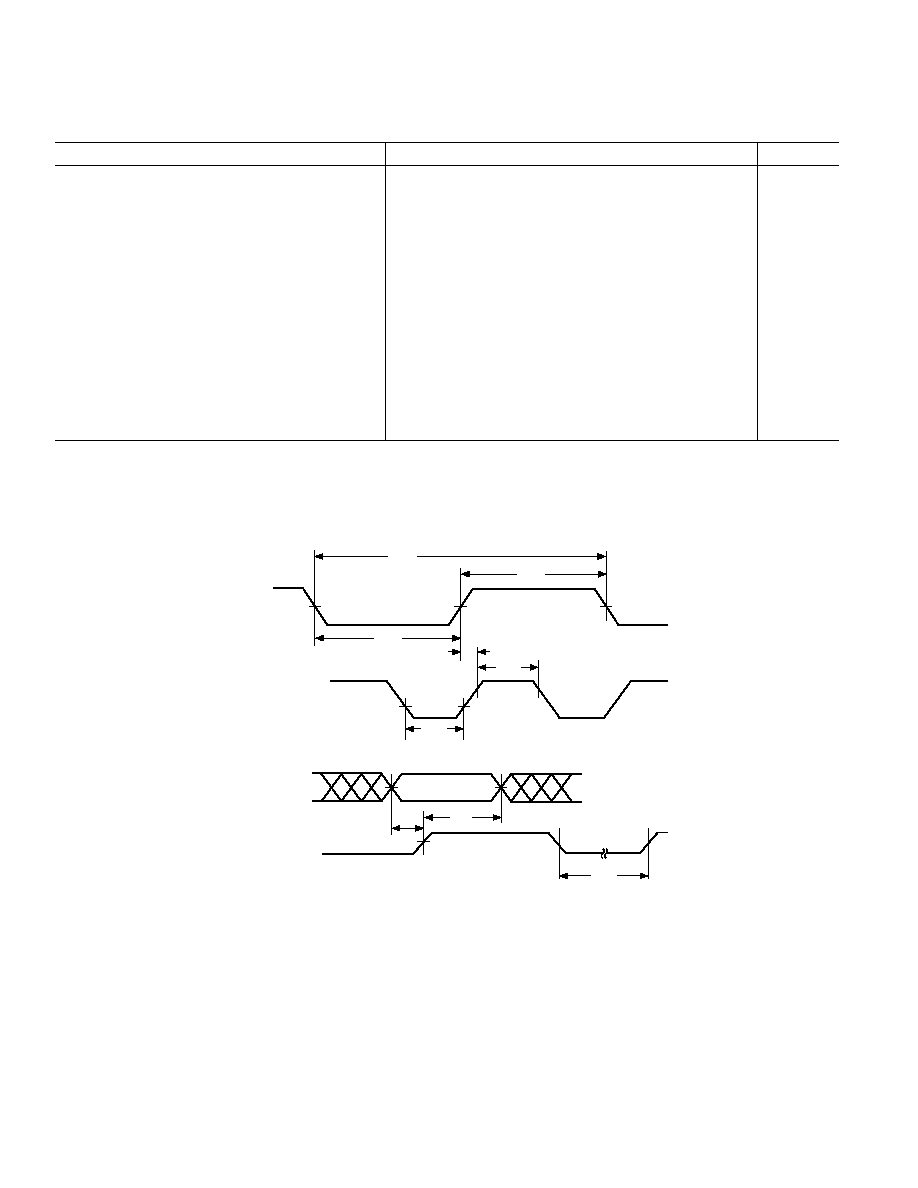
ADSP-2186L
≠16≠
REV. B
TIMING PARAMETERS
Parameter
Min
Max
Unit
Clock Signals and Reset
Timing Requirements:
t
CKI
CLKIN Period
50
150
ns
t
CKIL
CLKIN Width Low
20
ns
t
CKIH
CLKIN Width High
20
ns
Switching Characteristics:
t
CKL
CLKOUT Width Low
0.5 t
CK
≠ 7
ns
t
CKH
CLKOUT Width High
0.5 t
CK
≠ 7
ns
t
CKOH
CLKIN High to CLKOUT High
0
20
ns
Control Signals
Timing Requirements:
t
RSP
RESET Width Low
1
5 t
CK
ns
t
MS
Mode Setup before
RESET High
2
ns
t
MH
Mode Setup after
RESET High
5
ns
NOTE
1
Applies after power-up sequence is complete. Internal phase lock loop requires no more than 2000 CLKIN cycles assuming stable CLKIN (not including crystal
oscillator start-up time).
t
RSP
t
CKOH
t
CKI
t
CKIH
t
CKIL
t
CKH
t
CKL
t
MH
t
MS
CLKIN
CLKOUT
PF(2:0)
*
RESET
*
PF2 IS MODE C, PF1 IS MODE B, PF0 IS MODE A
Figure 11. Clock Signals
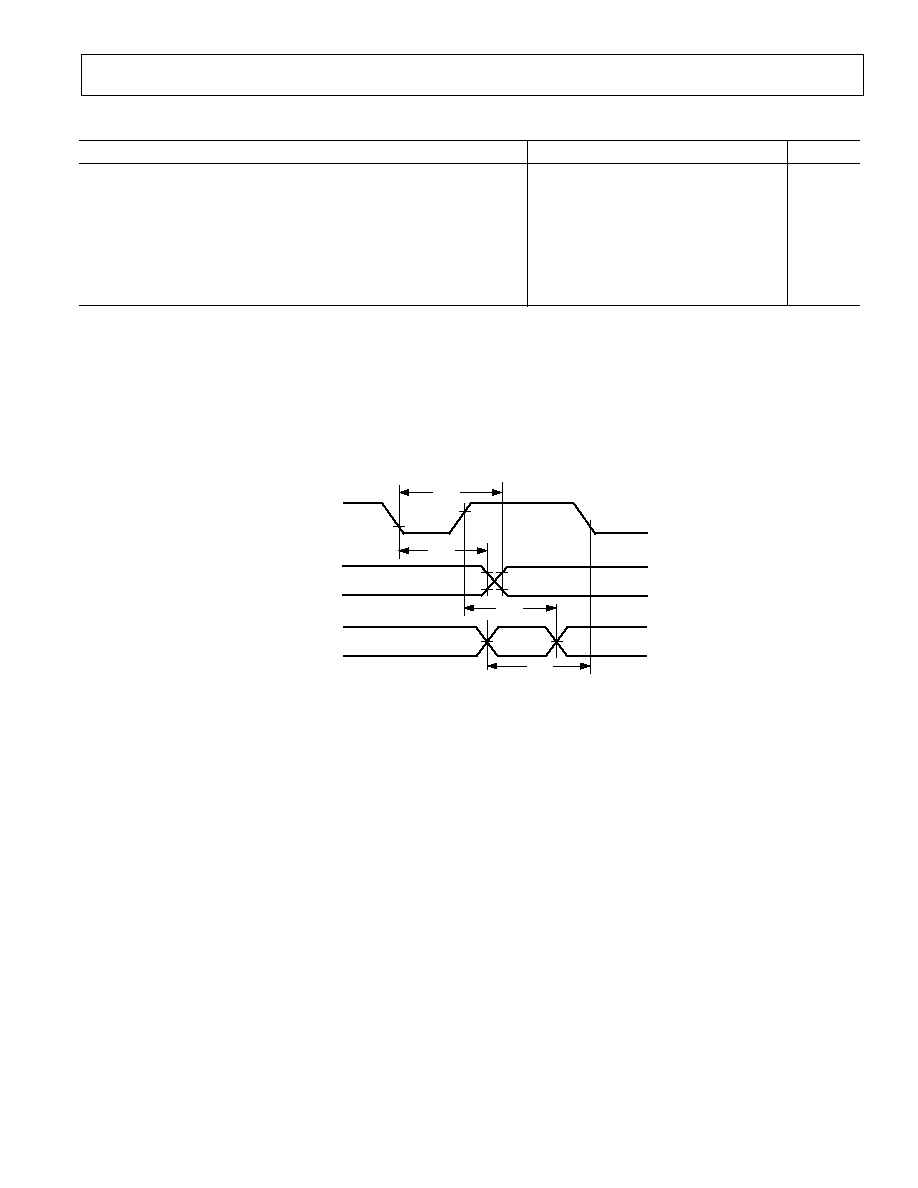
ADSP-2186L
≠17≠
REV. B
TIMING PARAMETERS
Parameter
Min
Max
Unit
Interrupts and Flag
Timing Requirements:
t
IFS
IRQx, FI, or PFx Setup before CLKOUT Low
1, 2, 3, 4
0.25 t
CK
+ 15
ns
t
IFH
IRQx, FI, or PFx Hold after CLKOUT High
1, 2, 3, 4
0.25 t
CK
ns
Switching Characteristics:
t
FOH
Flag Output Hold after CLKOUT Low
5
0.25 t
CK
≠ 7
ns
t
FOD
Flag Output Delay from CLKOUT Low
5
0.5 t
CK
+ 6
ns
NOTES
1
If
IRQx and FI inputs meet t
IFS
and t
IFH
setup/hold requirements, they will be recognized during the current clock cycle; otherwise the signals will be recognized on
the following cycle. (Refer to "Interrupt Controller Operation" in the Program Control chapter of the ADSP-218x DSP Hardware Reference, for further information
on interrupt servicing.)
2
Edge-sensitive interrupts require pulsewidths greater than 10 ns; level-sensitive interrupts must be held low until serviced.
3
IRQx = IRQ0, IRQ1, IRQ2, IRQL0, IRQL1, IRQE.
4
PFx = PF0, PF1, PF2, PF3, PF4, PF5, PF6, PF7.
5
Flag outputs = PFx, FL0, FL1, FL2, FO.
t
FOD
t
FOH
t
IFH
t
IFS
CLKOUT
FLAG
OUTPUTS
IRQx
FI
PFx
Figure 12. Interrupts and Flags
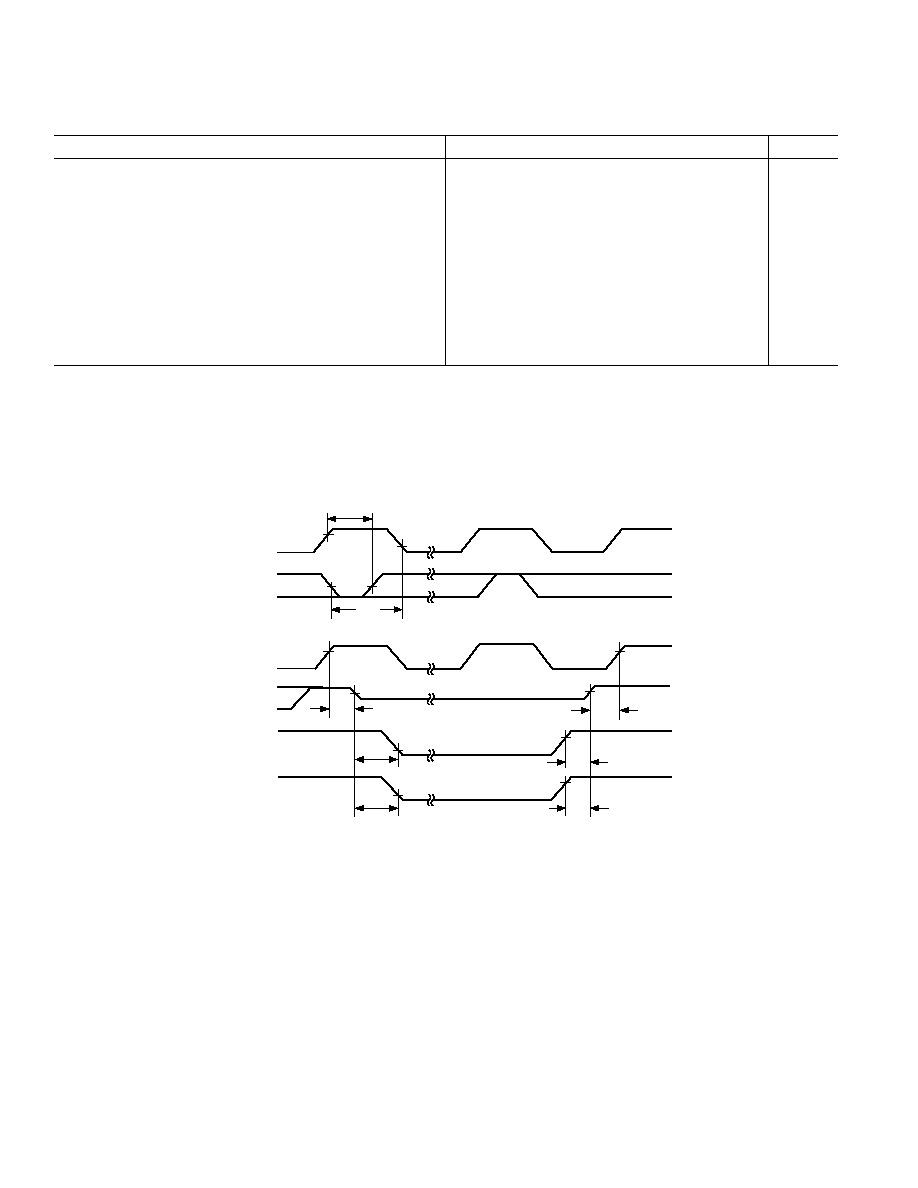
ADSP-2186L
≠18≠
REV. B
Parameter
Min
Max
Unit
Bus Request≠Bus Grant
Timing Requirements:
t
BH
BR Hold after CLKOUT High
1
0.25 t
CK
+ 2
ns
t
BS
BR Setup before CLKOUT Low
1
0.25 t
CK
+ 17
ns
Switching Characteristics:
t
SD
CLKOUT High to
xMS, RD, WR Disable
0.25 t
CK
+ 10
ns
t
SDB
xMS, RD, WR Disable to BG Low
0
ns
t
SE
BG High to xMS, RD, WR Enable
0
ns
t
SEC
xMS, RD, WR Enable to CLKOUT High
0.25 t
CK
≠ 7
ns
t
SDBH
xMS, RD, WR Disable to BGH Low
2
0
ns
t
SEH
BGH High to xMS, RD, WR Enable
2
0
ns
NOTES
xMS = PMS, DMS, CMS, IOMS, BMS.
1
BR is an asynchronous signal. If BR meets the setup/hold requirements, it will be recognized during the current clock cycle; otherwise the signal will be recognized on
the following cycle. Refer to the ADSP-218x DSP Hardware Reference, for
BR/BG cycle relationships.
2
BGH is asserted when the bus is granted and the processor requires control of the bus to continue.
CLKOUT
t
SD
t
SDB
t
SE
t
SEC
t
SDBH
t
SEH
t
BS
BR
t
BH
CLKOUT
PMS, DMS
BMS, RD
WR
BG
BGH
Figure 13. Bus Request≠Bus Grant

ADSP-2186L
≠19≠
REV. B
TIMING PARAMETERS
Parameter
Min
Max
Unit
Memory Read
Timing Requirements:
t
RDD
RD Low to Data Valid
0.5 t
CK
≠ 9 + w
ns
t
AA
A0≠A13,
xMS to Data Valid
0.75 t
CK
≠ 12.5 + w
ns
t
RDH
Data Hold from
RD High
1
ns
Switching Characteristics:
t
RP
RD Pulsewidth
0.5 t
CK
≠ 5 + w
ns
t
CRD
CLKOUT High to
RD Low
0.25 t
CK
≠ 5
0.25 t
CK
+ 7
ns
t
ASR
A0≠A13,
xMS Setup before RD Low
0.25 t
CK
≠ 6
ns
t
RDA
A0≠A13,
xMS Hold after RD Deasserted
0.25 t
CK
≠ 3
ns
t
RWR
RD High to RD or WR Low
0.5 t
CK
≠ 5
ns
w = wait states
◊ t
CK
.
xMS = PMS, DMS, CMS, IOMS, BMS.
CLKOUT
A0≠A13
t
RDA
t
RWR
t
RP
t
ASR
t
CRD
t
RDD
t
AA
t
RDH
DMS, PMS,
BMS, IOMS,
CMS
RD
WR
D0≠D23
Figure 14. Memory Read

ADSP-2186L
≠20≠
REV. B
Parameter
Min
Max
Unit
Memory Write
Switching Characteristics:
t
DW
Data Setup before
WR High
0.5 t
CK
≠ 7+ w
ns
t
DH
Data Hold after
WR High
0.25 t
CK
≠ 2
ns
t
WP
WR Pulsewidth
0.5 t
CK
≠ 5 + w
ns
t
WDE
WR Low to Data Enabled
0
ns
t
ASW
A0≠A13,
xMS Setup before WR Low
0.25 t
CK
≠ 6
ns
t
DDR
Data Disable before
WR or RD Low
0.25 t
CK
≠ 7
ns
t
CWR
CLKOUT High to
WR Low
0.25 t
CK
≠ 5
0.25 t
CK
+ 7
ns
t
AW
A0≠A13,
xMS, Setup before WR Deasserted
0.75 t
CK
≠ 9 + w
ns
t
WRA
A0≠A13,
xMS Hold after WR Deasserted
0.25 t
CK
≠ 3
ns
t
WWR
WR High to RD or WR Low
0.5 t
CK
≠ 5
ns
w = wait states
◊ t
CK
.
xMS = PMS, DMS, CMS, IOMS, BMS.
CLKOUT
A0≠A13
t
WP
t
AW
t
CWR
t
DH
t
WDE
t
DW
t
ASW
t
WWR
t
WRA
t
DDR
DMS, PMS,
BMS, CMS,
IOMS
RD
WR
D0≠D23
Figure 15. Memory Write
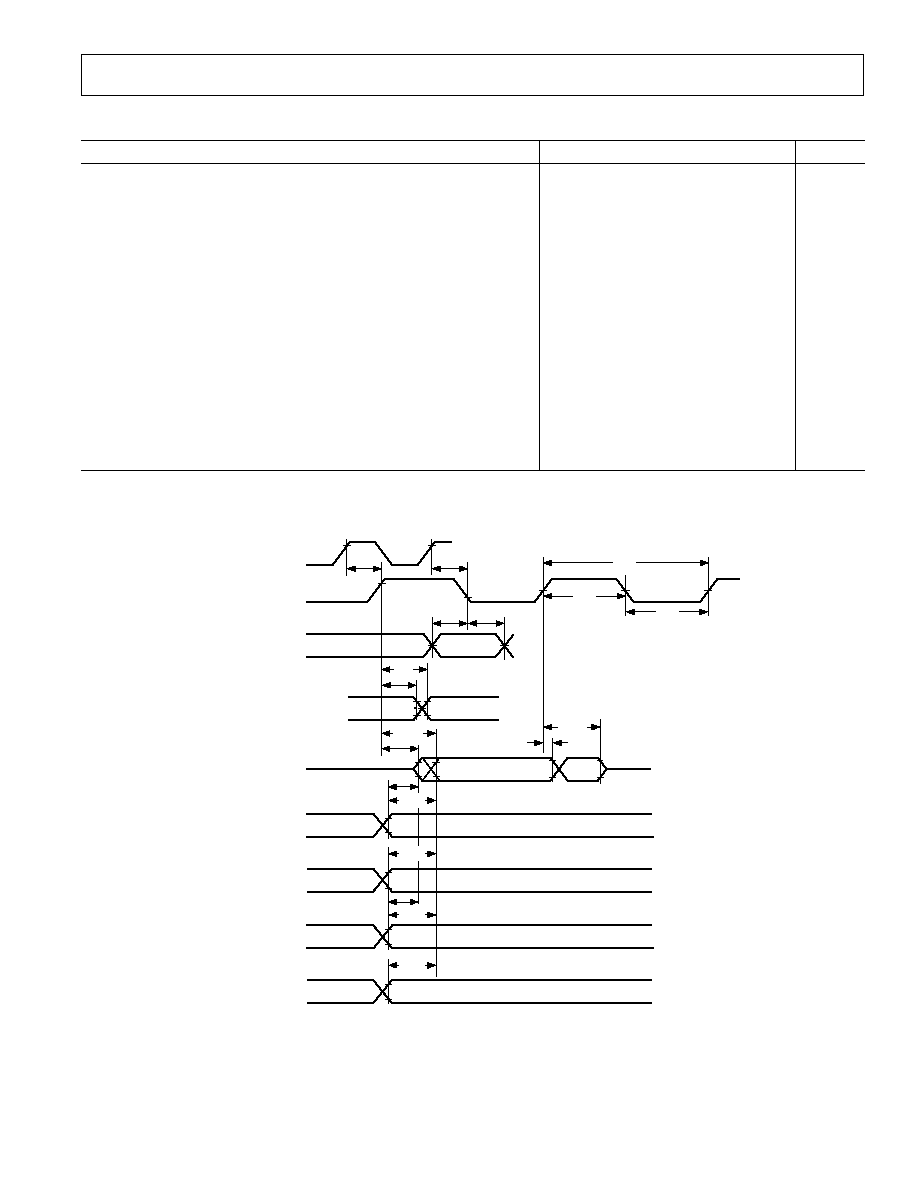
ADSP-2186L
≠21≠
REV. B
TIMING PARAMETERS
Parameter
Min
Max
Unit
Serial Ports
Timing Requirements:
t
SCK
SCLK Period
50
ns
t
SCS
DR/TFS/RFS Setup before SCLK Low
4
ns
t
SCH
DR/TFS/RFS Hold after SCLK Low
8
ns
t
SCP
SCLK
IN
Width
20
ns
Switching Characteristics:
t
CC
CLKOUT High to SCLK
OUT
0.25 t
CK
0.25 t
CK
+ 10
ns
t
SCDE
SCLK High to DT Enable
0
ns
t
SCDV
SCLK High to DT Valid
15
ns
t
RH
TFS/RFS
OUT
Hold after SCLK High
0
ns
t
RD
TFS/RFS
OUT
Delay from SCLK High
15
ns
t
SCDH
DT Hold after SCLK High
0
ns
t
TDE
TFS (Alt) to DT Enable
0
ns
t
TDV
TFS (Alt) to DT Valid
14
ns
t
SCDD
SCLK High to DT Disable
15
ns
t
RDV
RFS
(Multichannel, Frame Delay Zero) to DT Valid
15
ns
CLKOUT
SCLK
TFS
OUT
RFS
OUT
DT
ALTERNATE
FRAME MODE
t
CC
t
CC
t
SCS
t
SCH
t
RH
t
SCDE
t
SCDH
t
SCDD
t
TDE
t
RDV
MULTICHANNEL MODE,
FRAME DELAY 0
(MFD = 0)
DR
TFS
IN
RFS
IN
RFS
OUT
TFS
OUT
t
TDV
t
SCDV
t
RD
t
SCP
t
SCK
t
SCP
TFS
IN
RFS
IN
ALTERNATE
FRAME MODE
t
RDV
MULTICHANNEL MODE,
FRAME DELAY 0
(MFD = 0)
t
TDV
t
TDE
Figure 16. Serial Ports
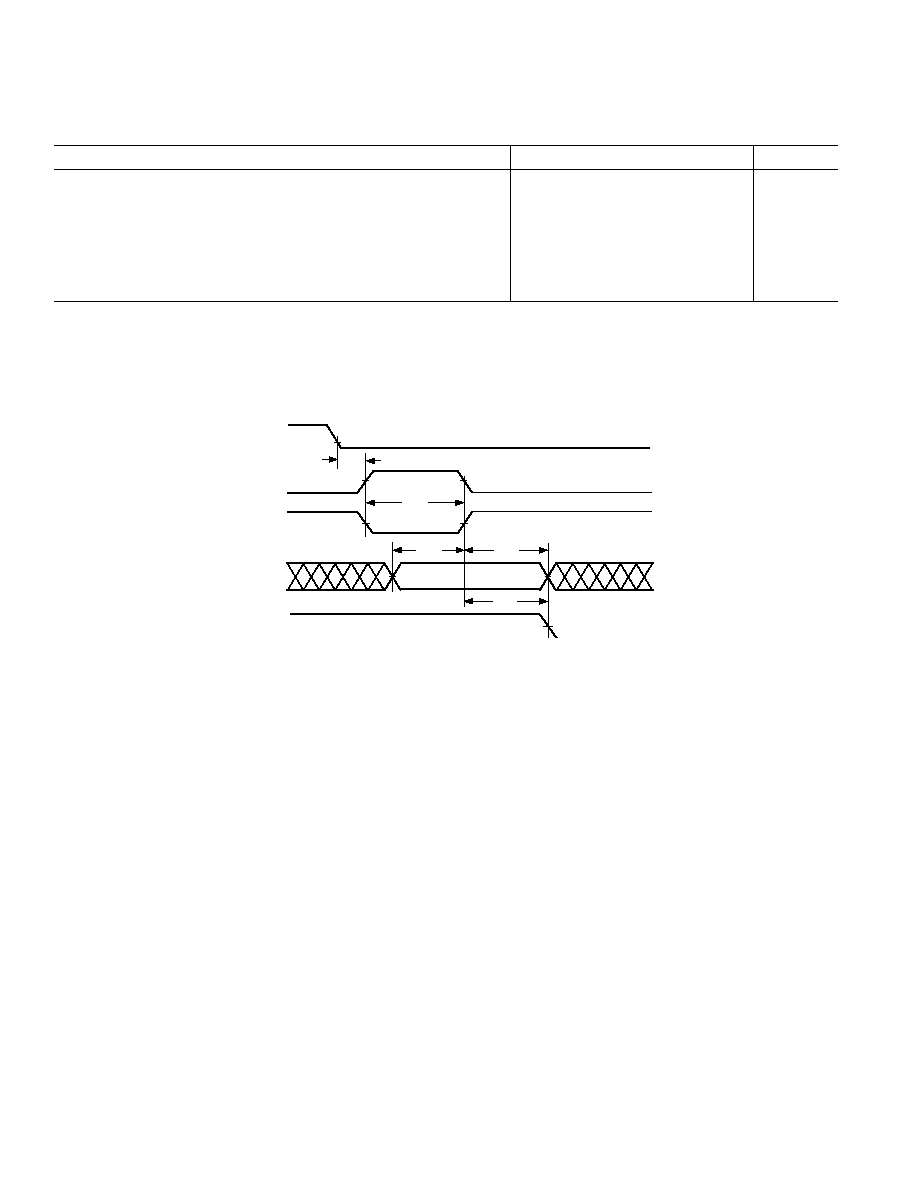
ADSP-2186L
≠22≠
REV. B
Parameter
Min
Max
Unit
IDMA Address Latch
Timing Requirements:
t
IALP
Duration of Address Latch
1, 3
10
ns
t
IASU
IAD15≠0 Address Setup before Address Latch End
3
5
ns
t
IAH
IAD15≠0 Address Hold after Address Latch End
3
3
ns
t
IKA
IACK Low before Start of Address Latch
2, 3
0
ns
t
IALS
Start of Write or Read after Address Latch End
2, 3
3
ns
NOTES
1
Start of Address Latch =
IS Low and IAL High.
2
Start of Write or Read =
IS Low and IWR Low or IRD Low.
3
End of Address Latch =
IS High or IAL Low.
t
IKA
IAD15≠0
IACK
IAL
IS
IRD
IWR
OR
t
IALP
t
IASU
t
IAH
t
IALS
Figure 17. IDMA Address Latch
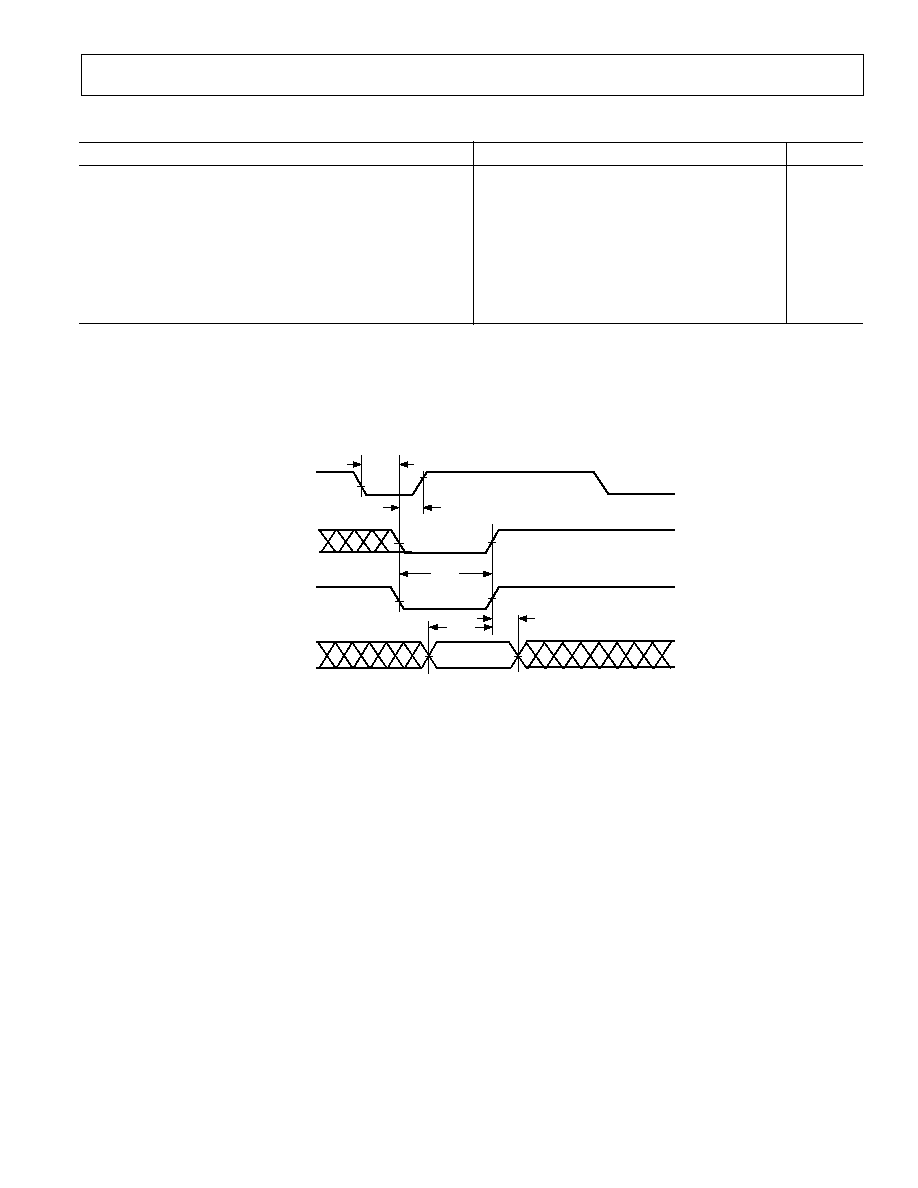
ADSP-2186L
≠23≠
REV. B
TIMING PARAMETERS
Parameter
Min
Max
Unit
IDMA Write, Short Write Cycle
Timing Requirements:
t
IKW
IACK Low before Start of Write
1
0
ns
t
IWP
Duration of Write
1, 2
15
ns
t
IDSU
IAD15≠0 Data Setup before End of Write
2, 3, 4
5
ns
t
IDH
IAD15≠0 Data Hold after End of Write
2, 3, 4
2
ns
Switching Characteristics:
t
IKHW
Start of Write to
IACK High
17
ns
NOTES
1
Start of Write =
IS Low and IWR Low.
2
End of Write =
IS High or IWR High.
3
If Write Pulse ends before
IACK Low, use specifications t
IDSU
, t
IDH
.
4
If Write Pulse ends after
IACK Low, use specifications t
IKSU
, t
IKH
.
IAD15≠0
DATA
t
IKHW
t
IKW
t
IDSU
IACK
t
IWP
t
IDH
IS
IWR
Figure 18. IDMA Write, Short Write Cycle

ADSP-2186L
≠24≠
REV. B
Parameter
Min
Max
Unit
IDMA Write, Long Write Cycle
Timing Requirements:
t
IKW
IACK Low before Start of Write
1
0
ns
t
IKSU
IAD15≠0 Data Setup before
IACK Low
2, 3, 4
0.5 t
CK
+ 10
ns
t
IKH
IAD15≠0 Data Hold after
IACK Low
2, 3, 4
2
ns
Switching Characteristics:
t
IKLW
Start of Write to
IACK Low
4
1.5 t
CK
ns
t
IKHW
Start of Write to
IACK High
17
ns
NOTES
1
Start of Write =
IS Low and IWR Low.
2
If Write Pulse ends before
IACK Low, use specifications t
IDSU
, t
IDH
.
3
If Write Pulse ends after
IACK Low, use specifications t
IKSU
, t
IKH
.
4
This is the earliest time for
IACK Low from Start of Write. For IDMA Write cycle relationships, please refer to the ADSP-218x DSP Hardware Reference.
IAD15≠0
DATA
t
IKHW
t
IKW
IACK
IS
IWR
t
IKLW
t
IKH
t
IKSU
Figure 19. IDMA Write, Long Write Cycle
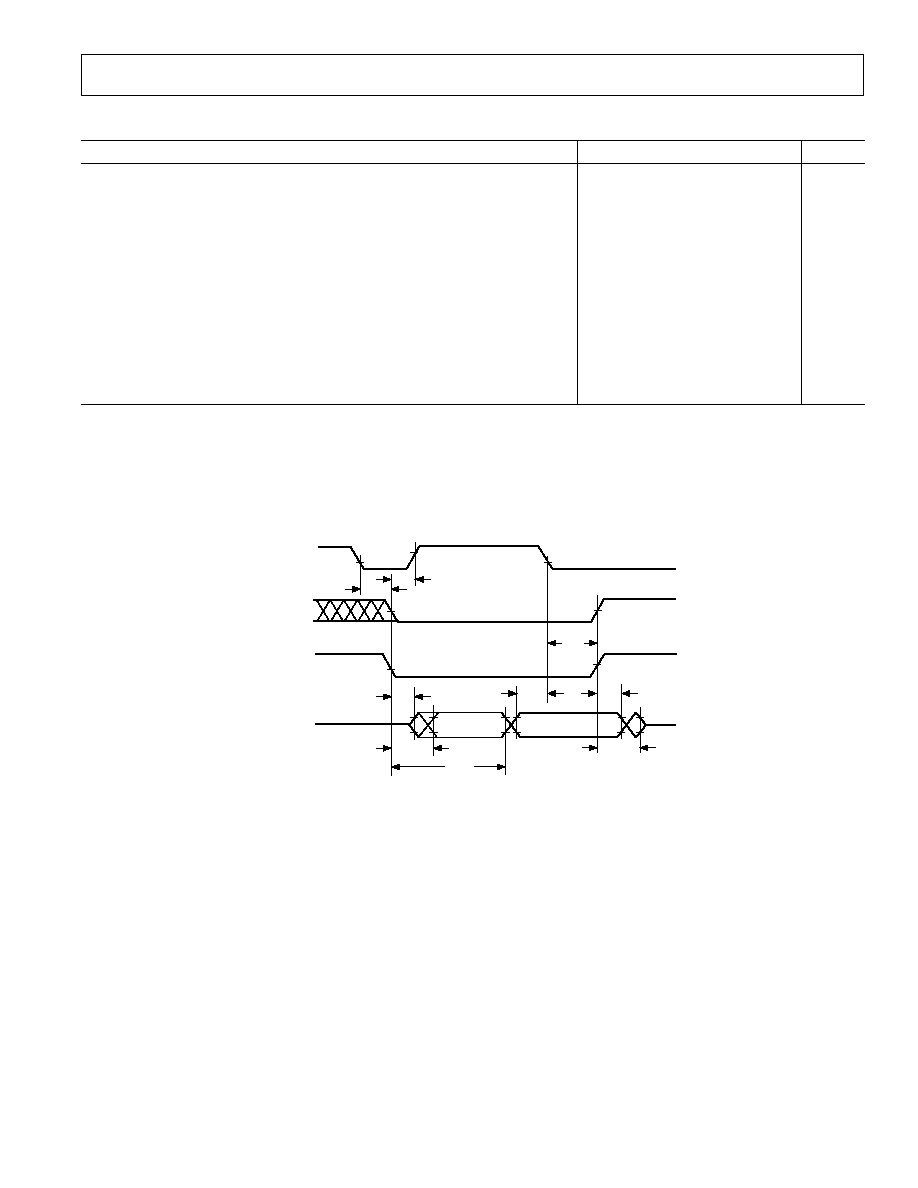
ADSP-2186L
≠25≠
REV. B
TIMING PARAMETERS
Parameter
Min
Max
Unit
IDMA Read, Long Read Cycle
Timing Requirements:
t
IKR
IACK Low before Start of Read
1
0
ns
t
IRK
End of Read after
IACK Low
2
ns
Switching Characteristics:
t
IKHR
IACK High after Start of Read
1
17
ns
t
IKDS
IAD15≠0 Data Setup before
IACK Low
0.5 t
CK
≠ 10
ns
t
IKDH
IAD15≠0 Data Hold after End of Read
2
0
ns
t
IKDD
IAD15≠0 Data Disabled after End of Read
2
10
ns
t
IRDE
IAD15≠0 Previous Data Enabled after Start of Read
0
ns
t
IRDV
IAD15≠0 Previous Data Valid after Start of Read
15
ns
t
IRDH1
IAD15≠0 Previous Data Hold after Start of Read (DM/PM1)
3
2 t
CK
≠ 5
ns
t
IRDH2
IAD15≠0 Previous Data Hold after Start of Read (PM2)
4
t
CK
≠ 5
ns
NOTES
1
Start of Read =
IS Low and IRD Low.
2
End of Read =
IS High or IRD High.
3
DM read or first half of PM read.
4
Second half of PM read.
t
IRK
t
IKR
PREVIOUS
DATA
READ
DATA
t
IKHR
t
IKDS
t
IRDV
t
IRDH
t
IKDD
t
IRDE
t
IKDH
IAD15≠0
IACK
IS
IRD
Figure 20. IDMA Read, Long Read Cycle
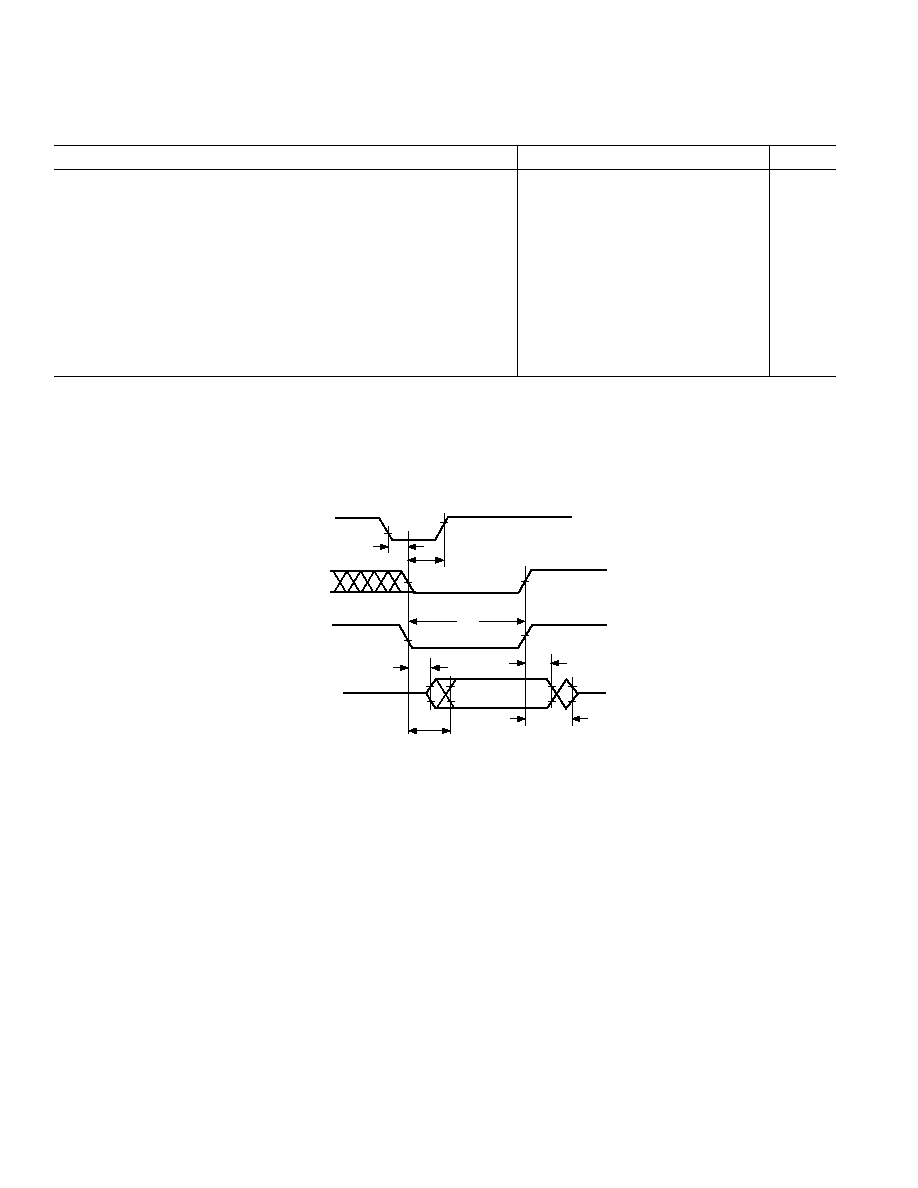
ADSP-2186L
≠26≠
REV. B
Parameter
Min
Max
Unit
IDMA Read, Short Read Cycle
Timing Requirements:
t
IKR
IACK Low before Start of Read
1
0
ns
t
IRP1
Duration of Read (DM/PM1)
2
15
2t
CK
≠ 5
ns
t
IRP2
Duration of Read (PM2)
3
15
t
CK
≠ 5
ns
Switching Characteristics:
t
IKHR
IACK High after Start of Read
1
15
ns
t
IKDH
IAD15≠0 Data Hold after End of Read
4
0
ns
t
IKDD
IAD15≠0 Data Disabled after End of Read
4
10
ns
t
IRDE
IAD15≠0 Previous Data Enabled after Start of Read
0
ns
t
IRDV
IAD15≠0 Previous Data Valid after Start of Read
15
ns
NOTES
1
Start of Read =
IS Low and IRD Low.
2
DM Read or First Half of PM Read.
3
Second Half of PM Read.
4
End of Read =
IS High or IRD High.
t
IRP
t
IKR
PREVIOUS
DATA
t
IKHR
t
IRDV
t
IKDD
t
IRDE
t
IKDH
IAD15≠0
IACK
IS
IRD
Figure 21. IDMA Read, Short Read Cycle
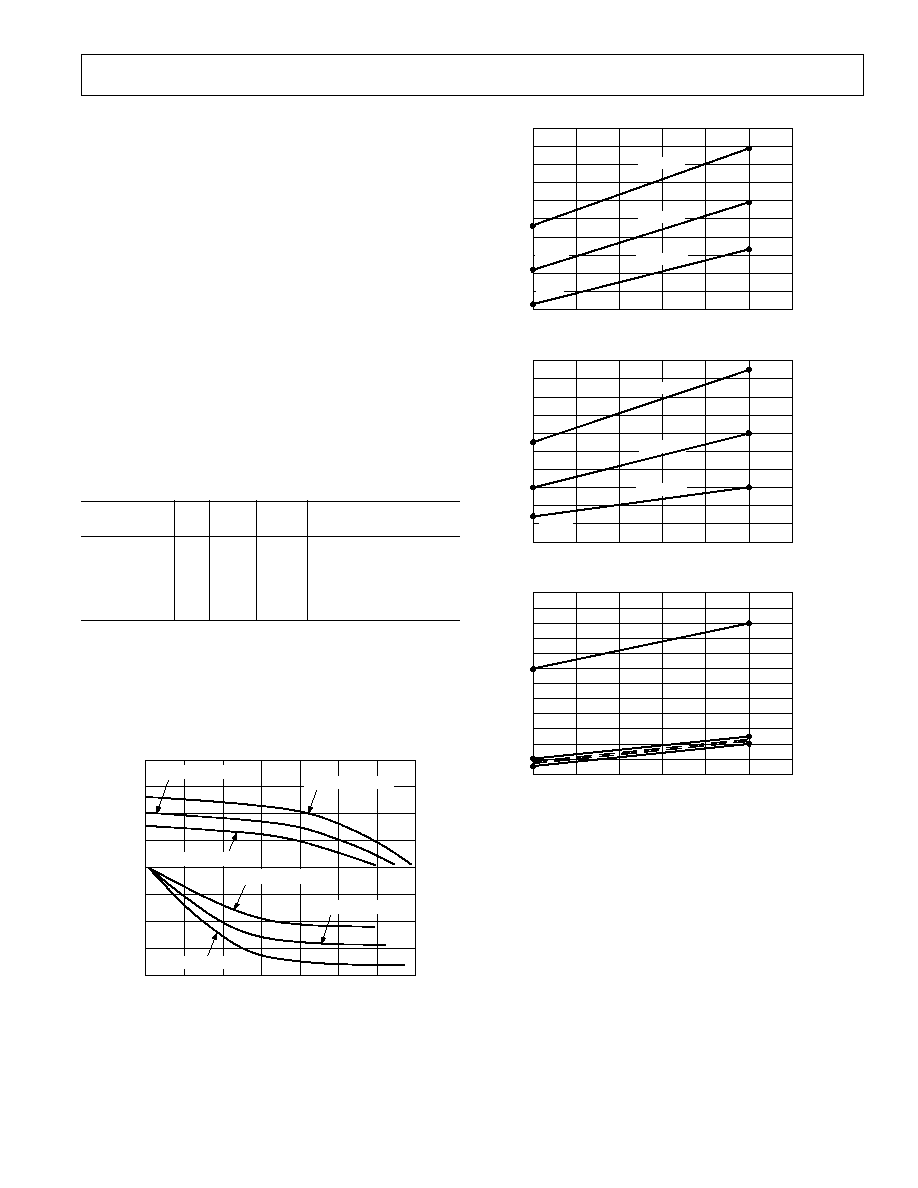
ADSP-2186L
≠27≠
REV. B
POWER DISSIPATION
To determine total power dissipation in a specific application,
the following equation should be applied for each output:
C
◊ V
DD
2
◊ f
C = load capacitance, f = output switching frequency.
Example
In an application where external data memory is used and no
other outputs are active, power dissipation is calculated as follows:
Assumptions
∑ External data memory is accessed every cycle with 50% of the
address pins switching.
∑ External data memory writes occur every other cycle with
50% of the data pins switching.
∑ Each address and data pin has a 10 pF total load at the pin.
∑ The application operates at V
DD
= 3.3 V and t
CK
= 30 ns.
Total Power Dissipation = P
INT
+ (C
◊ V
DD
2
◊ f)
P
INT
= internal power dissipation from Power vs. Frequency
graph (Figure 23).
(C
◊ V
DD
2
◊ f ) is calculated for each output:
# of
Pins
◊ C
◊ V
DD
2
◊ f
Address
7
◊ 10 pF ◊ 3.3
2
V
◊ 16.67 MHz = 12.7 mW
Data Output,
WR 9
◊ 10 pF ◊ 3.3
2
V
◊ 16.67 MHz = 16.3 mW
RD
1
◊ 10 pF ◊ 3.3
2
V
◊ 16.67 MHz =
1.8 mW
CLKOUT,
DMS
2
◊ 10 pF ◊ 3.3
2
V
◊ 33.3 MHz =
7.2 mW
38.0 mW
Total power dissipation for this example is PINT + 38.0 mW.
Output Drive Currents
Figure 22 shows typical I-V characteristics for the output drivers
of the ADSP-2186L. The curves represent the current drive
capability of the output drivers as a function of output voltage.
SOURCE VOLTAGE ≠ V
0
3.5
0.5
1
1.5
2
2.5
3
80
≠80
SOURCE CURRENT
≠
mA
60
0
≠20
≠40
≠60
40
20
V
DD
= 3.3V @ +25 C
V
DD
= 3.6V @ ≠40 C
V
DD
= 3.0V @ +85 C
V
DD
= 3.3V @ +25 C
V
DD
= 3.0V @ +85 C
V
DD
= 3.6V @ ≠40 C
V
OH
V
OL
Figure 22. Typical Output Driver Characteristics
VALID FOR ALL TEMPERATURE GRADES.
1
POWER REFLECTS DEVICE OPERATING WITH NO OUTPUT LOADS.
2
TYPICAL POWER DISSIPATION AT 3.3V V
DD
AND T
A
= 25 C EXCEPT WHERE
SPECIFIED.
3
I
DD
MEASUREMENT TAKEN WITH ALL INSTRUCTIONS EXECUTING FROM
INTERNAL MEMORY. 50% OF THE INSTRUCTIONS ARE MULTIFUNCTION
(TYPES 1, 4, 5, 12, 13, 14), 30% ARE TYPE 2 AND TYPE 6, AND 20% ARE
IDLE INSTRUCTIONS.
4
IDLE REFERS TO ADSP-2186L STATE OF OPERATION DURING EXECUTION
OF IDLE INSTRUCTION. DEASSERTED PINS ARE DRIVEN TO EITHER V
DD
.
OR GND.
28
8
26
16
14
12
10
24
22
18
20
POWER (P
IDLE
n
)
≠
mW
1/t
CK
≠ MHz
30
32
34
36
38
40
42
22mW
12mW
13mW
28mW
IDLE (16)
IDLE (128)
IDLE
POWER, IDLE n MODES
2
30
32
10mW
9mW
16
36
26
24
22
20
34
32
28
30
18
POWER (P
IDLE
)
≠
mW
1/t
CK
≠ MHz
42
30
32
34
36
38
40
27mW
35mW
V
DD
= 3.6V
22mW
28mW
V
DD
= 3.3V
19mW
22mW
V
DD
= 3.0V
POWER, IDLE
1, 2, 4
1/t
CK
≠ MHz
42
30
32
34
36
38
40
180
80
170
120
110
100
90
160
150
130
140
126mW
102mW
83mW
139mW
113mW
V
DD
= 3.6V
V
DD
= 3.3V
V
DD
= 3.0V
2186L POWER, INTERNAL
1, 2, 3
169mW
POWER (P
INT
)
≠
mW
Figure 23. Power vs. Frequency

ADSP-2186L
≠28≠
REV. B
CAPACITIVE LOADING
Figures 24 and 25 show the capacitive loading characteristics of
the ADSP-2186L.
C
L
≠ pF
25
20
0
0
200
20
RISE TIME (0.4V
≠
2.4V)
≠
ns
40
60
80
100
120
140
160
180
15
10
5
V
DD
= 3.0V
T = 85 C
Figure 24. Typical Output Rise Time vs. Load Capacitance,
C
L
(at Maximum Ambient Operating Temperature)
C
L
≠ pF
14
0
VALID OUTPUT DELAY OR HOLD
≠
ns
50
100
150
250
200
12
4
2
≠2
10
8
NOMINAL
16
18
6
≠4
≠6
V
DD
= 3.0V
T = 85 C
≠3
Figure 25. Typical Output Valid Delay or Hold vs. Load
Capacitance, C
L
(at Maximum Ambient Operating
Temperature)
TEST CONDITIONS
Output Disable Time
Output pins are considered to be disabled when they have
stopped driving and started a transition from the measured
output high or low voltage to a high impedance state. The out-
put disable time (t
DIS
) is the difference between t
MEASURED
and
t
DECAY
, as shown in the Output Enable/Disable diagram. The
time is the interval from when a reference signal reaches a high
or low voltage level to when the output voltages have changed
by 0.5 V from the measured output high or low voltage. The
decay time, t
DECAY
, is dependent on the capacitive load, C
L
, and
the current load, i
L
, on the output pin. It can be approximated
by the following equation:
t
DECAY
=
C
L
◊ 0.5V
i
L
from which
t
DIS
= t
MEASURED
≠ t
DECAY
is calculated. If multiple pins (such as the data bus) are
disabled, the measurement value is that of the last pin to
stop driving.
1.5V
1.5V
INPUT
OR
OUTPUT
Figure 26. Voltage Reference Levels for AC Measure-
ments (Except Output Enable/Disable)
Output Enable Time
Output pins are considered to be enabled when they have made
a transition from a high-impedance state to when they start
driving. The output enable time (t
ENA
) is the interval from when
a reference signal reaches a high or low voltage level to when the
output has reached a specified high or low trip point, as shown
in the Output Enable/Disable diagram. If multiple pins (such as
the data bus) are enabled, the measurement value is that of the
first pin to start driving.
2.0V
1.0V
t
ENA
REFERENCE
SIGNAL
OUTPUT
t
DECAY
V
OH
(MEASURED)
OUTPUT STOPS
DRIVING
OUTPUT STARTS
DRIVING
t
DIS
t
MEASURED
V
OL
(MEASURED)
V
OH
(MEASURED) ≠ 0.5V
V
OL
(MEASURED) +0.5V
HIGH-IMPEDANCE STATE. TEST CONDITIONS CAUSE
THIS VOLTAGE LEVEL TO BE APPROXIMATELY 1.5V.
V
OH
(MEASURED)
V
OL
(MEASURED)
Figure 27. Output Enable/Disable
TO
OUTPUT
PIN
50pF
+1.5V
I
OH
I
OL
Figure 28. Equivalent Device Loading for AC Measure-
ments (Including All Fixtures)

ADSP-2186L
≠29≠
REV. B
TEMPERATURE ≠ C
10k
0
CURRENT
≠
A
1k
100
10
1
25
55
85
V
DD
= 3.6V
V
DD
= 3.3V
Figure 29. Power-Down Graph
ENVIRONMENTAL CONDITIONS
Ambient Temperature Rating:
T
AMB
=
T
CASE
≠ (PD
◊
CA
)
T
CASE
=
Case Temperature in
∞C
PD
=
Power Dissipation in W
CA
=
Thermal Resistance (Case-to-Ambient)
JA
=
Thermal Resistance (Junction-to-Ambient)
JC
=
Thermal Resistance (Junction-to-Case)
Package
JA
JC
CA
LQFP
50
∞C/W
2
∞C/W
48
∞C/W
Mini-BGA
70.7
∞C/W
7.4
∞C/W
63.3
∞C/W

ADSP-2186L
≠30≠
REV. B
100-Lead LQFP Package Pinout
5
4
3
2
7
6
9
8
1
D19
D18
D17
D16
IRQE
+PF4
IRQL0
+PF5
GND
IRQL1
+PF6
DT0
TFS0
SCLK0
VDD
DT1/FO
TFS1/
IRQ1
RFS1/
IRQ0
DR1/FI
GND
SCLK1
ERESET
RESET
D15
D14
D13
D12
GND
D11
D10
D9
VDD
GND
D8
D7/
IWR
D6/
IRD
D5/IAL
D4/
IS
GND
VDD
D3/
IACK
D2/IAD15
D1/IAD14
D0/IAD13
BG
EBG
BR
EBR
A4/IAD3
A5/IAD4
GND
A6/IAD5
A7/IAD6
A8/IAD7
A9/IAD8
A10/IAD9
A11/IAD10
A12/IAD11
A13/IAD12
GND
CLKIN
XTAL
VDD
CLKOUT
GND
VDD
WR
RD
BMS
DMS
PMS
IOMS
CMS
71
72
73
74
69
70
67
68
65
66
75
60
61
62
63
58
59
56
57
54
55
64
52
53
51
10
0
99
98
97
96
95
94
93
92
91
90
89
88
87
86
85
84
83
82
81
80
79
78
77
76
PIN 1
IDENTIFIER
TOP VIEW
(Not to Scale)
26
27
28
29
30
31
32
33
34
35
36
37
38
39
40
41
42
43
44
45
46
47
48
49
50
11
10
16
15
14
13
18
17
20
19
22
21
12
24
23
25
ADSP-2186L
IRQ2
+PF7
RFS0
DR0
EMS
EE
ELOUT
ECLK
ELIN
EINT
A3/IAD2
A2/IAD1
A1/IAD0
A0
PWDACK
BGH
FL0
FL1
FL2
D23
D22
D21
D20
GND
PF1 [MODE B]
GND
PWD
VDD
PF0 [MODE A]
PF2 [MODE C]
PF3

ADSP-2186L
≠31≠
REV. B
LQFP Pin Configurations
LQFP
Pin
LQFP
Pin
LQFP
Pin
LQFP
Pin
Number
Name
Number
Name
Number
Name
Number
Name
1
A4/IAD3
26
IRQE + PF4
51
EBR
76
D16
2
A5/IAD4
27
IRQL0 + PF5
52
BR
77
D17
3
GND
28
GND
53
EBG
78
D18
4
A6/IAD5
29
IRQL1 + PF6
54
BG
79
D19
5
A7/IAD6
30
IRQ2 + PF7
55
D0/IAD13
80
GND
6
A8/IAD7
31
DT0
56
D1/IAD14
81
D20
7
A9/IAD8
32
TFS0
57
D2/IAD15
82
D21
8
A10/IAD9
33
RFS0
58
D3/IACK
83
D22
9
A11/IAD10
34
DR0
59
VDD
84
D23
10
A12/IAD11
35
SCLK0
60
GND
85
FL2
11
A13/IAD12
36
VDD
61
D4/IS
86
FL1
12
GND
37
DT1/FO
62
D5/IAL
87
FL0
13
CLKIN
38
TFS1/
IRQ1
63
D6/IRD
88
PF3
14
XTAL
39
RFS1/
IRQ0
64
D7/IWR
89
PF2 [Mode C]
15
VDD
40
DR1/FI
65
D8
90
VDD
16
CLKOUT
41
GND
66
GND
91
PWD
17
GND
42
SCLK1
67
VDD
92
GND
18
VDD
43
ERESET
68
D9
93
PF1 [Mode B]
19
WR
44
RESET
69
D10
94
PF0 [Mode A]
20
RD
45
EMS
70
D11
95
BGH
21
BMS
46
EE
71
GND
96
PWDACK
22
DMS
47
ECLK
72
D12
97
A0
23
PMS
48
ELOUT
73
D13
98
A1/IAD0
24
IOMS
49
ELIN
74
D14
99
A2/IAD1
25
CMS
50
EINT
75
D15
100
A3/IAD2
The ADSP-2186L package pinout is shown in the table below. Pin names in bold text replace the plain text named functions when
Mode C = 1. A + sign separates two functions when either function can be active for either major I/O mode. Signals enclosed in
brackets [ ] are state bits latched from the value of the pin at the deassertion of
RESET.

ADSP-2186L
≠32≠
REV. B
ADSP-2186L Mini-BGA (CA) Package Pinout
Bottom View
12
11
10
9
8
7
6
5
4
3
2
1
A
B
C
D
E
F
G
H
J
K
L
M
GND
GND
D22
NC
NC
NC
GND
NC
A0
GND
A1/IAD0
A2/IAD1
D16
D17
D18
D20
D23
VDD
GND
NC
NC
GND
A3/IAD2
A4/IAD3
D14
NC
D15
D19
D21
VDD
PWD
A7/IAD6
A5/IAD4
RD
A6/IAD5
PWDACK
GND
NC
D12
D13
NC
PF2
[MODE C]
PF1
[MODE B]
A9/IAD8
BGH
NC
WR
NC
D10
GND
VDD
GND
GND
PF3
FL2
PF0
[MODE A]
FL0
A8/IAD7
VDD
VDD
D9
NC
D8
D11
D7/
IWR
NC
NC
FL1
A11/
IAD10
A12/
IAD11
NC
A13/
IAD12
D4/
IS
NC
NC
D5/IAL
D6/
IRD
NC
NC
NC
A10/IAD9
GND
NC
XTAL
GND
NC
GND
D3/
IACK D2/IAD15
TFS0
DT0
VDD
GND
GND
GND
CLKIN
VDD
VDD
D1/IAD14
BG
RFS1/
IRQ0
D0/IAD13
SCLK0
VDD
VDD
NC
VDD
CLKOUT
EBG
BR
EBR
ERESET
SCLK1
TFS1/
IRQ1
RFS0
DMS
BMS
NC
NC
NC
EINT
ELOUT
ELIN
RESET
GND
DR0
PMS
GND
IOMS
IRQL1
+PF6
NC
ECLK
EE
EMS
NC
GND
DR1/
FI
DT1/
FO
GND
CMS
NC
IRQ2
+PF7
IRQL0
+PF5
IRQE
+PF4

ADSP-2186L
≠33≠
REV. B
The ADSP-2186L Mini-BGA package pinout is shown in the table below. Pin names in bold text replace the plain text named func-
tions when Mode C = 1. A + sign separates two functions when either function can be active for either major I/O mode. Signals
enclosed in brackets [ ] are state bits latched from the value of the pin at the deassertion of
RESET.
Mini-BGA Package Pinout
Ball #
Name
Ball #
Name
Ball #
Name
Ball #
Name
A01
A2/IAD1
D01
N/C
G01
XTAL
K01
N/C
A02
A1/IAD0
D02
WR
G02
N/C
K02
N/C
A03
GND
D03
N/C
G03
GND
K03
N/C
A04
A0
D04
BGH
G04
A10/IAD9
K04
BMS
A05
N/C
D05
A9/IAD8
G05
N/C
K05
DMS
A06
GND
D06
PF1[MODE B]
G06
N/C
K06
RFS0
A07
N/C
D07
PF2[MODE C]
G07
N/C
K07
TFS1/
IRQ1
A08
N/C
D08
N/C
G08
D6/IRD
K08
SCLK1
A09
N/C
D09
D13
G09
D5/IAL
K09
ERESET
A10
D22
D10
D12
G10
N/C
K10
EBR
A11
GND
D11
N/C
G11
N/C
K11
BR
A12
GND
D12
GND
G12
D4/IS
K12
EBG
B01
A4/IAD3
E01
VDD
H01
CLKIN
L01
IRQE+PF4
B02
A3/IAD2
E02
VDD
H02
GND
L02
N/C
B03
GND
E03
A8/IAD7
H03
GND
L03
IRQL1+PF6
B04
N/C
E04
FL0
H04
GND
L04
IOMS
B05
N/C
E05
PF0[MODE A]
H05
VDD
L05
GND
B06
GND
E06
FL2
H06
DT0
L06
PMS
B07
VDD
E07
PF3
H07
TFS0
L07
DR0
B08
D23
E08
GND
H08
D2/IAD15
L08
GND
B09
D20
E09
GND
H09
D3/IACK
L09
RESET
B10
D18
E10
VDD
H10
GND
L10
ELIN
B11
D17
E11
GND
H11
N/C
L11
ELOUT
B12
D16
E12
D10
H12
GND
L12
EINT
C01
PWDACK
F01
A13/IAD12
J01
CLKOUT
M01
IRQL0+PF5
C02
A6/IAD5
F02
N/C
J02
VDD
M02
IRQ2+PF7
C03
RD
F03
A12/IAD11
J03
N/C
M03
N/C
C04
A5/IAD4
F04
A11/IAD10
J04
VDD
M04
CMS
C05
A7/IAD6
F05
FL1
J05
VDD
M05
GND
C06
PWD
F06
N/C
J06
SCLK0
M06
DT1/FO
C07
VDD
F07
N/C
J07
D0/IAD13
M07
DR1/FI
C08
D21
F08
D7/IWR
J08
RFS1/
IRQ0
M08
GND
C09
D19
F09
D11
J09
BG
M09
N/C
C10
D15
F10
D8
J10
D1/IAD14
M10
EMS
C11
N/C
F11
N/C
J11
VDD
M11
EE
C12
D14
F12
D9
J12
VDD
M12
ECLK

ADSP-2186L
≠34≠
REV. B
OUTLINE DIMENSIONS
Dimensions shown in millimeters.
100-Lead Metric Thin Plastic Quad Flatpack (LQFP)
(ST-100)
NOTE
THE ACTUAL POSITION OF EACH LEAD IS WITHIN 0.08
FROM ITS IDEAL POSITION WHEN MEASURED IN THE
LATERAL DIRECTION.
TOP VIEW
(PINS DOWN)
1
25
26
51
50
75
76
100
16.20
16.00 SQ
15.80
14.05
14.00 SQ
13.95
12.00
BSC
0.50 BSC
LEAD PITCH
0.27
0.22 TYP
0.17
LEAD WIDTH
7
0
1.60 MAX
SEATING
PLANE
12
TYP
0.75
0.60 TYP
0.50
0.08
MAX LEAD
COPLANARITY
10
6
2
0.15
0.05

ADSP-2186L
≠35≠
REV. B
144-Ball Metric Mini-BGA
(CA-144)
NOTES
1. THE ACTUAL POSITION OF THE BALL POPULATON
IS WITHIN 0.150 OF ITS IDEAL POSITION RELATIVE
TO THE PACKAGE EDGES.
2. THE ACTUAL POSITION OF EACH BALL IS WITHIN
0.08 OF ITS IDEAL POSITION RELATIVE TO THE
BALL POPULATION.
SEATING
PLANE
1.00
0.85
DETAIL A
0.55
0.50
0.45
BALL DIAMETER
0.12
MAX
0.40
0.25
1.40
MAX
DETAIL A
0.80
BSC
8.80
BSC
0.80 BSC
8.80 BSC
A
B
C
D
E
F
G
H
J
K
L
M
12 11 10 9 8 7 6 5 4 3 2 1
TOP VIEW
10.10
10.00 SQ
9.90
10.10
10.00 SQ
9.90
OUTLINE DIMENSIONS
Dimensions shown in millimeters.
ORDERING GUIDE
Ambient
Instruction
Temperature
Rate
Package
Package
Part Number
Range
(MHz)
Description
Option
*
ADSP-2186LKST-115
0
∞C to +70∞C
28.8
100-Lead LQFP
ST-100
ADSP-2186LBST-115
≠40
∞C to +85∞C
28.8
100-Lead LQFP
ST-100
ADSP-2186LKST-133
0
∞C to +70∞C
33.3
100-Lead LQFP
ST-100
ADSP-2186LBST-133
≠40
∞C to +85∞C
33.3
100-Lead LQFP
ST-100
ADSP-2186LKST-160
0
∞C to +70∞C
40.0
100-Lead LQFP
ST-100
ADSP-2186LBST-160
≠40
∞C to +85∞C
40.0
100-Lead LQFP
ST-100
ADSP-2186LBCA-160
≠40
∞C to +85∞C
40.0
144-Ball Mini-BGA
CA-144
*ST = Plastic Thin Quad Flatpack (LQFP); CA = Mini-BGA.

≠36≠
PRINTED IN U.S.A.
C00191b≠2.5≠3/01(B)



































